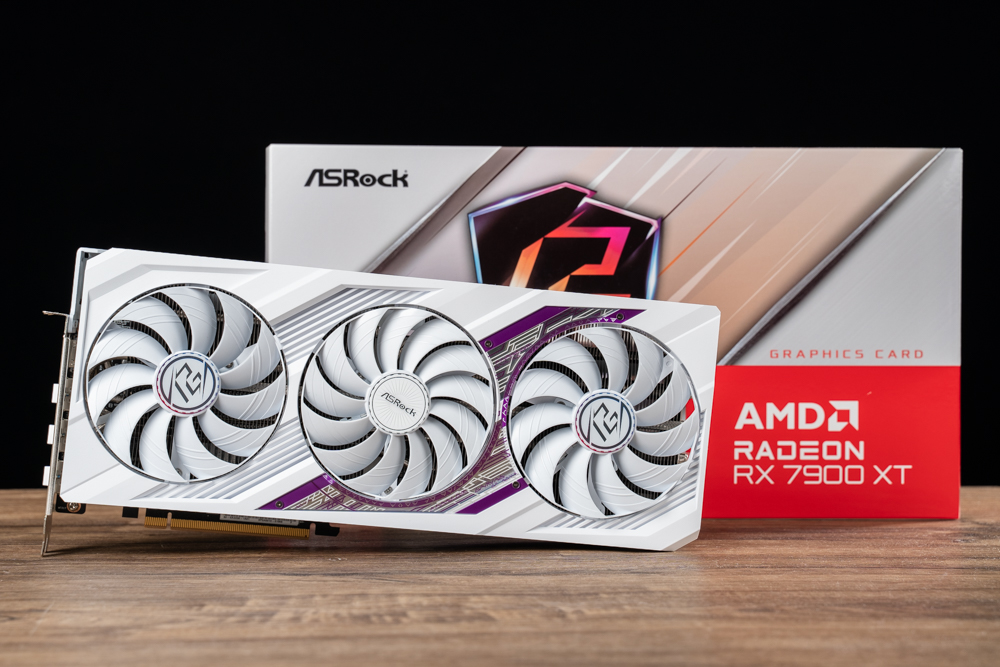
ASRock’s Phantom Gaming series has unveiled an exclusive white edition cooler for the AMD Radeon RX 7900 XT, embodying a luxurious esports design aesthetic. This high-end gaming graphics card is engineered for peak performance, superior cooling, and striking design.
The AMD Radeon RX 7900 XT Phantom Gaming White 20GB OC features are noteworthy:
- GPU Core: AMD Radeon RX 7900 XT
- GPU Model: Navi 31
- Architecture: RDNA 3
- PCI Express: 4.0 x 16
- Stream Processors: 5376
- Infinity Cache: 80MB
- GPU Clock Speeds: Boost clock at 2450 MHz and game clock at 2075 MHz
- Memory Specs: 20GB GDDR6
- Memory Speed: 20 Gbps
- Memory Interface: 320-bit
- Dimensions: 330 x 140 x 57.6 mm
- Occupancy: 2.8 Slot
- Weight: 1450g
- Power Connectors: 2 x PCIe 8-Pin
- Recommended Power Supply: 750W
- DirectX: 12 Ultimate
- OpenGL: 4.6
- Display Outputs: 1x HDMI 2.1a, 3x DisplayPort 2.1
- Maximum Multi-Display Output: 4
This card is designed for gamers who demand the best in performance, cooling efficiency, and design. The luxurious white edition stands out visually and is packed with features catering to hardcore gaming needs. This card is a powerhouse, from its high stream processor count to the massive 20GB of GDDR6 memory, and the ability to connect up to four monitors. Its hefty 1450g weight and substantial size underscore its premium build quality and capability to handle demanding games with ease.
With support for the latest DirectX and OpenGL versions, gamers can expect cutting-edge visual effects and smoother gameplay. The recommended 750W power supply ensures this graphics card has all the power it needs for optimal performance.
The AMD Radeon RX 7900 XT Phantom Gaming White 20GB OC from ASRock is a testament to the fusion of performance, cooling, and design, making it a top choice for gamers seeking the ultimate gaming experience.
Unboxing the ASRock RX 7900 XT Phantom Gaming White: A Closer Look at Performance and Design
The AMD Radeon RX 7900 XT, a formidable contender within the RDNA3 architecture, boasts an impressive 84 Compute Units (CUs) and a substantial 80MB of Infinity Cache. It’s further equipped with 20GB of 320-bit GDDR6 VRAM, making it a powerhouse for gaming and professional applications alike. However, it’s noteworthy that, despite utilizing TSMC’s advanced 5nm+6nm manufacturing processes, its Total Board Power (TBP) still peaks at 315W, indicating a higher power consumption compared to its rivals.
ASRock has introduced two versions of the Phantom Gaming series graphics cards for the RX 7900 XT, available in both black and white finishes. The white version, which we’re exploring today, daringly incorporates purple motifs, adding a touch of sophistication and design complexity to its appearance. This model, like its elder sibling the RX 7900 XTX, features a 2.8-slot design, measures 330mm in length, and is cooled by a triple-fan setup, demonstrating ASRock’s commitment to using quality materials.
The bold use of color and intricate design details on the ASRock Phantom Gaming series RX 7900 XT white edition not only enhances its aesthetic appeal but also reflects a deep consideration for gamers and PC builders who value both form and function. The extensive cooling system, matched with the high-performance specs of the RX 7900 XT, ensures that this graphics card can handle demanding tasks and games with ease, although users should be mindful of the relatively high power requirements. This card represents a blend of cutting-edge technology and distinctive design, offering an engaging and powerful gaming experience.
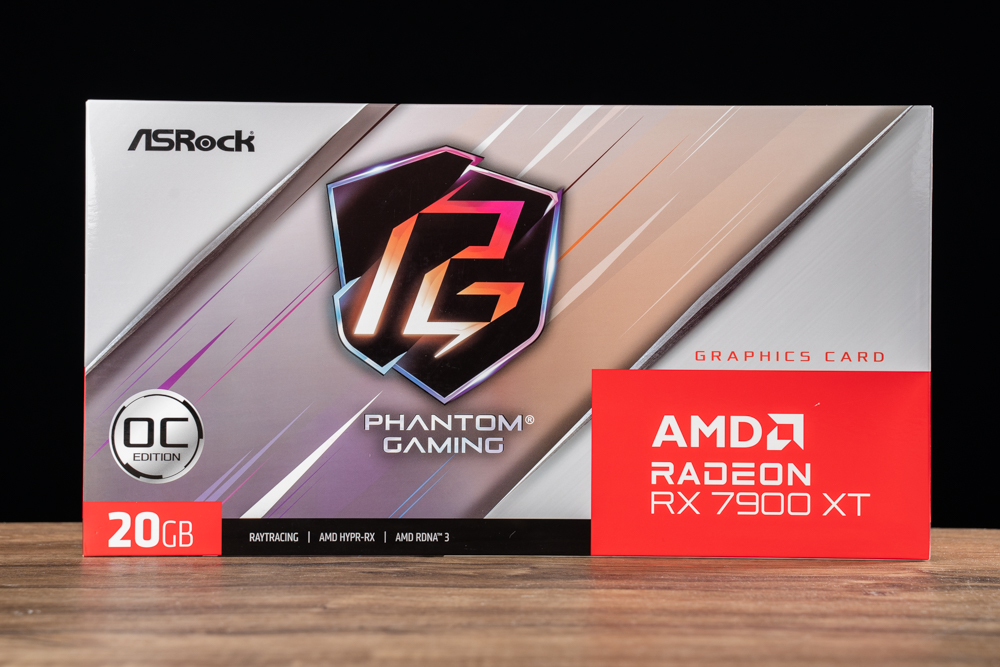
The packaging for the ASRock RX 7900 XT Phantom Gaming White edition is quite eye-catching. It prominently features the Phantom Gaming logo in a vibrant array of colours, set against a silver and white gradient background that speaks to its high-end status. The “OC Edition” badge suggests this card is overclocked for enhanced performance, appealing to enthusiasts looking to get the most out of their hardware.
The box also highlights several of the card’s key features, such as “20GB” of memory, which is quite substantial for demanding games and applications. The references to “Raytracing,” “AMD HyperX,” and “AMD RDNA™ 3” indicate support for the latest gaming technologies and graphics architecture, assuring buyers of its cutting-edge capabilities.
The design of the box, with its sharp angles and dynamic colour scheme, seems to reflect the gaming and esports spirit of the Phantom Gaming series, suggesting that what’s inside is crafted for performance and style. It’s a packaging that stands out and communicates the power and premium nature of the product within.
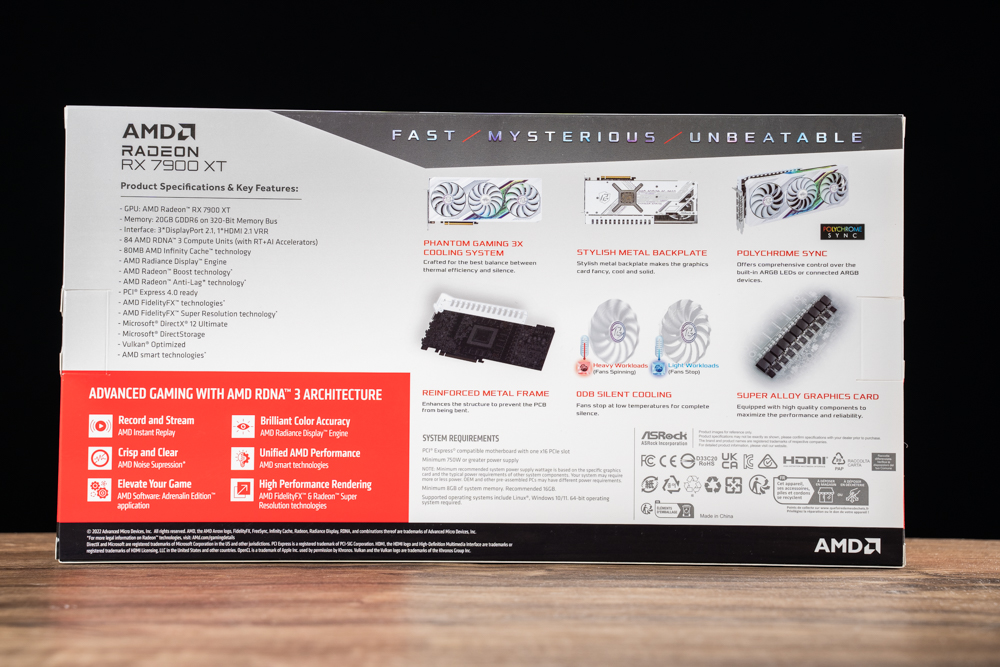
The back of the packaging for the ASRock RX 7900 XT Phantom Gaming White graphics card provides a comprehensive overview of the product’s specifications and key features, emphasizing its high-end gaming capabilities.
Key features include:
- GPU: AMD Radeon™ RX 7900 XT
- Memory: 20GB GDDR6 on a 320-bit memory bus
- Interface: 3xDisplayPort 2.1, 1xHDMI 2.1 VRR
- AMD RDNA™ 3 Architecture with Raytracing Accelerators
- Infinity Cache: 80MB
- AMD FidelityFX Super Resolution technology
- PCI Express® 4.0 ready
- Microsoft® DirectStorage
- Vulkan® Optimized
- Additional AMD smart technologies
The packaging also highlights the Advanced Gaming with AMD RDNA™ 3 Architecture benefits, such as:
- Record and Stream: With AMD Instant Replay
- Crisp and Clear: Thanks to the AMD Noise Suppression
- Elevate Your Game: With the AMD Software Adrenalin Edition application
- Brilliant Color Accuracy: Provided by the AMD Radeon™ Display Engine
- Unified AMD Performance: AMD AMD FidelityFX™ features
- High-Performance Rendering: With AMD FidelityFX™ Raytracing
The design elements reinforce the Phantom Gaming series’ focus on cooling and performance:
- Phantom Gaming 3X Cooling System: Engineered for the balance between thermal efficiency and silence.
- Stylish Metal Backplate: Enhances the card’s structural integrity and provides cooling.
- Polychrome Sync: Offers comprehensive control over auto-RGB LEDs on connected ASRock devices.
- Reinforced Metal Frame: Strengthens the structure to prevent PCB bending.
- 0dB Silent Cooling: Fans stop at low temperatures for complete silence.
- Super Alloy Graphics Card: Equipped with high-quality components to maximize performance and reliability.
The system requirements are clearly stated, ensuring potential buyers know the necessary setup to get the best experience with this card, including a minimum PSU recommendation of 750W and support for Windows 10/11 operating systems. The packaging, rich with detail, not only serves to inform but also to reassure the consumer of the premium nature of the product.
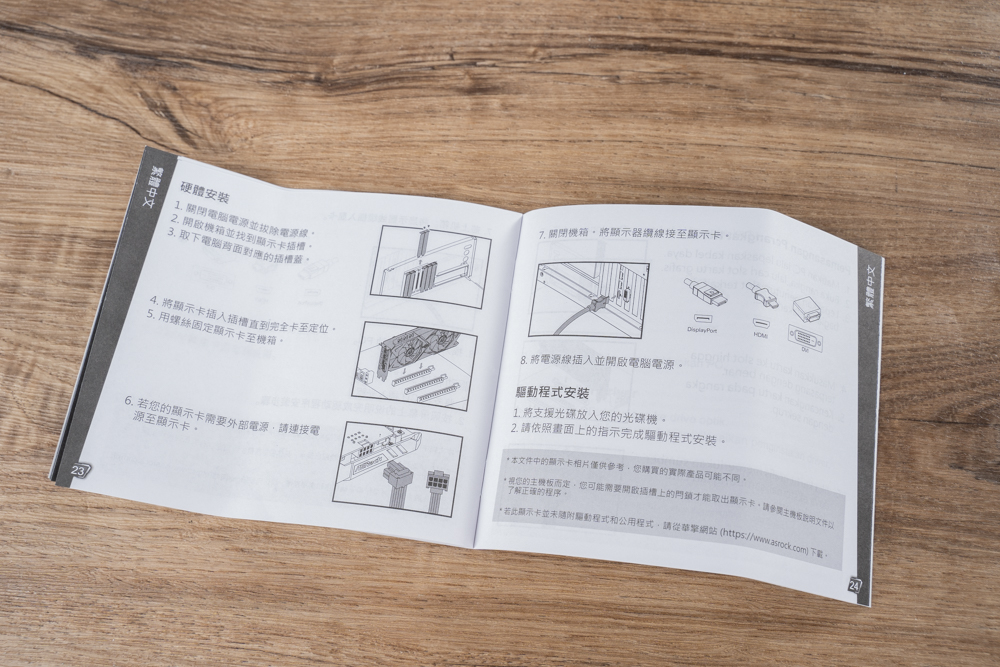
The image shows an instruction booklet that comes with the ASRock RX 7900 XT Phantom Gaming White graphics card. This kind of manual typically provides guidance on how to properly install the card into a computer system. It appears to cover the installation process in several detailed steps, with diagrams to visually aid the user. This booklet ensures that even users who may not be familiar with hardware installation can follow along and set up their new graphics card correctly.
In the step-by-step instructions, there may be illustrations of the different connectors and ports available on the card, such as DisplayPort and HDMI, along with any additional features or precautions to consider during installation. The simple inclusion of this manual might suggest that the graphics card package focuses on minimalism, providing just the essentials without extra accessories that might not be necessary for installation and operation.
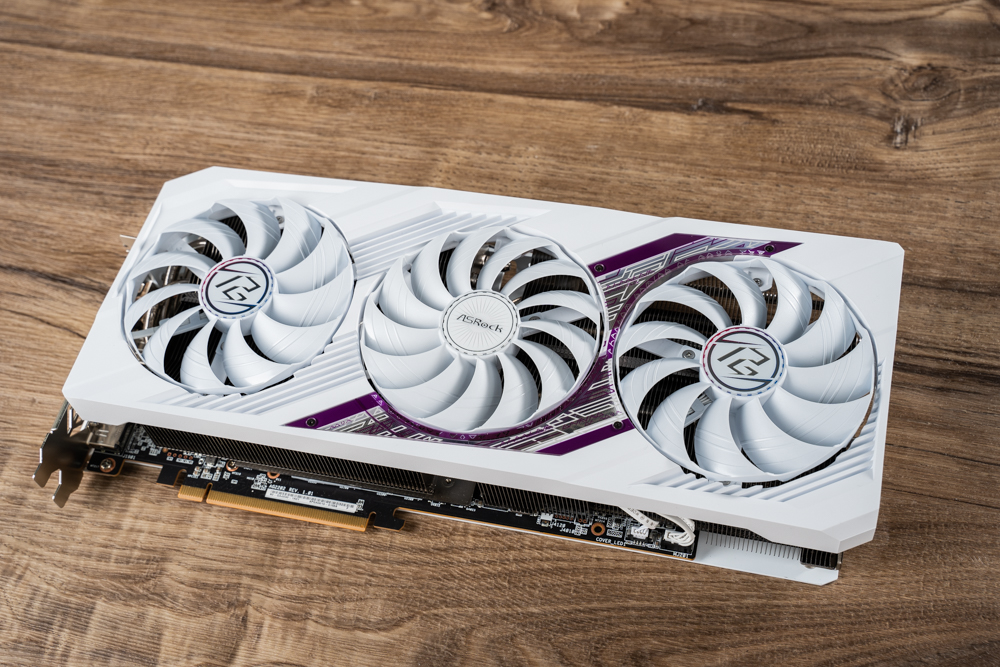
This image showcases the ASRock RX 7900 XT Phantom Gaming White graphics card from a front perspective. It’s equipped with three 100mm fans with striped ring designs that are seamlessly connected to the frame, enhancing the card’s overall airflow from the sides. The fan configuration employs the standard arrangement of alternate spinning directions—where the central fan rotates in the opposite direction to the two outer fans. This design is engineered to minimize turbulent flow and boost airflow efficiency, which is crucial for maintaining optimal cooling performance during intense gaming sessions or heavy workloads.
The graphics card features a “zero fan” mode, which allows the fans to stop spinning under low-temperature conditions, thereby reducing noise and extending the lifespan of the fans. This silent operation feature is a thoughtful inclusion for users who appreciate a quiet computing environment, especially during less demanding tasks where full cooling capacity is not required.
The design aesthetics, with its white and purple colour scheme, align with the Phantom Gaming series’ aim to deliver not just performance but also a visually striking component that can complement any gamer’s or enthusiast’s PC build. The emphasis on form and function highlights ASRock’s commitment to providing high-quality, high-performance gaming hardware.
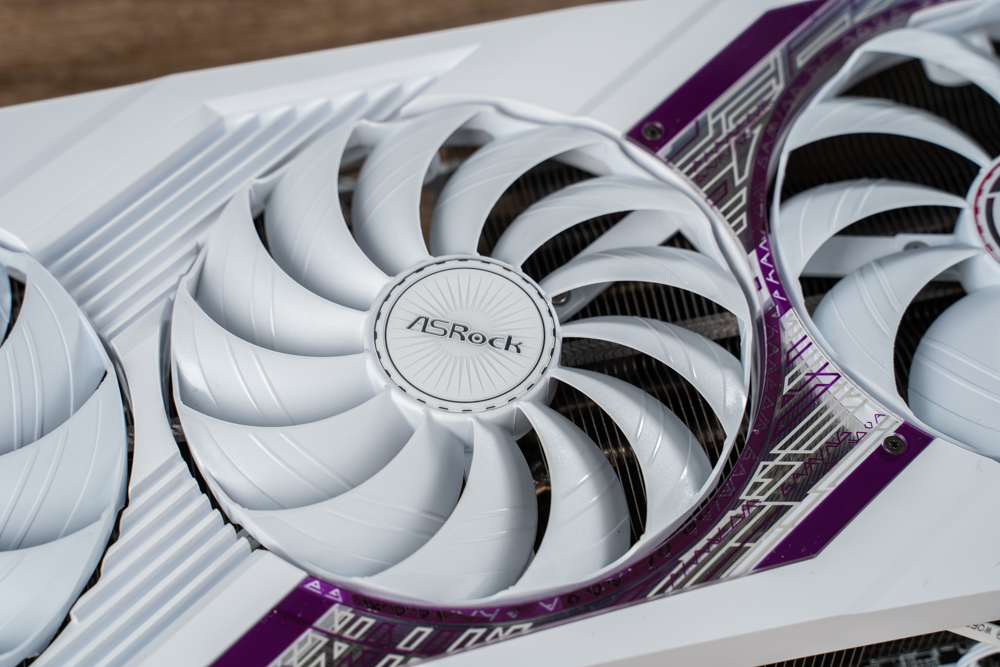
The close-up image vividly showcases the cooling system of the ASRock RX 7900 XT Phantom Gaming White graphics card, focusing on the 100mm striped ring fans. The fans are a pristine white, with a sleek curvature to the blades that suggests efficient airflow and a silent operation design. The central hub of each fan bears the ASRock logo, reaffirming the brand’s signature on this high-performance component.
Detailing around the fans reveals an elegant purple and silver geometric pattern, contributing to the card’s stylish aesthetic. This pattern is not just for looks; it’s strategically placed to guide airflow. Visible screws secure the fans to the card, indicating a robust and durable construction.
This image not only highlights the graphic card’s sophisticated cooling technology but also illustrates its attention to detail in design, promising to be an attractive and functional addition to any gamer or PC enthusiast’s setup.
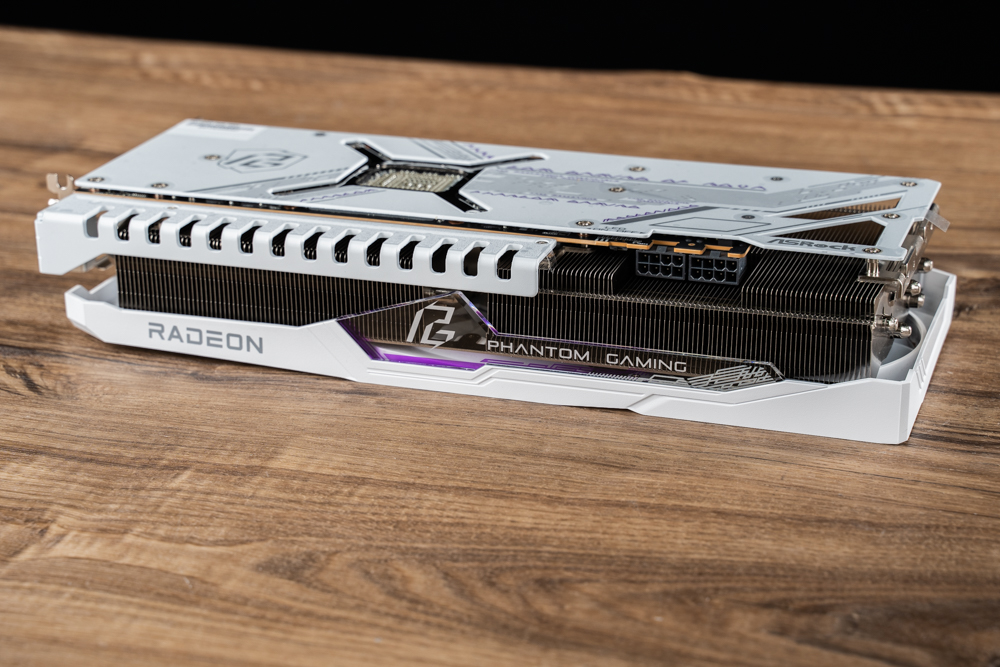
We see the ASRock RX 7900 XT Phantom Gaming White graphics card from a side angle, highlighting its robust build quality. The card is equipped with a reinforced metal mid-frame, which serves to enhance its structural rigidity, ensuring durability and maintaining the card’s shape over time. This metal mid-frame is also part of the card’s aesthetic, contributing to its high-end look and sleek, metallic finish.
The “Radeon” and “Phantom Gaming” branding are prominently featured on the side of the card, indicating its powerful Radeon chipset and its belonging to the high-performance Phantom Gaming product line. The striking purple accents stand out against the white and metallic color scheme, giving the card a distinctive and dynamic appearance.
The power connectors are also visible in the image, indicating the card’s energy requirements, and the array of heat sink fins, suggesting an advanced cooling system designed to manage the heat generated during operation. The meticulous attention to detail in the design underscores the premium nature of the product, aimed at gamers and PC enthusiasts who demand both visual appeal and performance from their hardware.
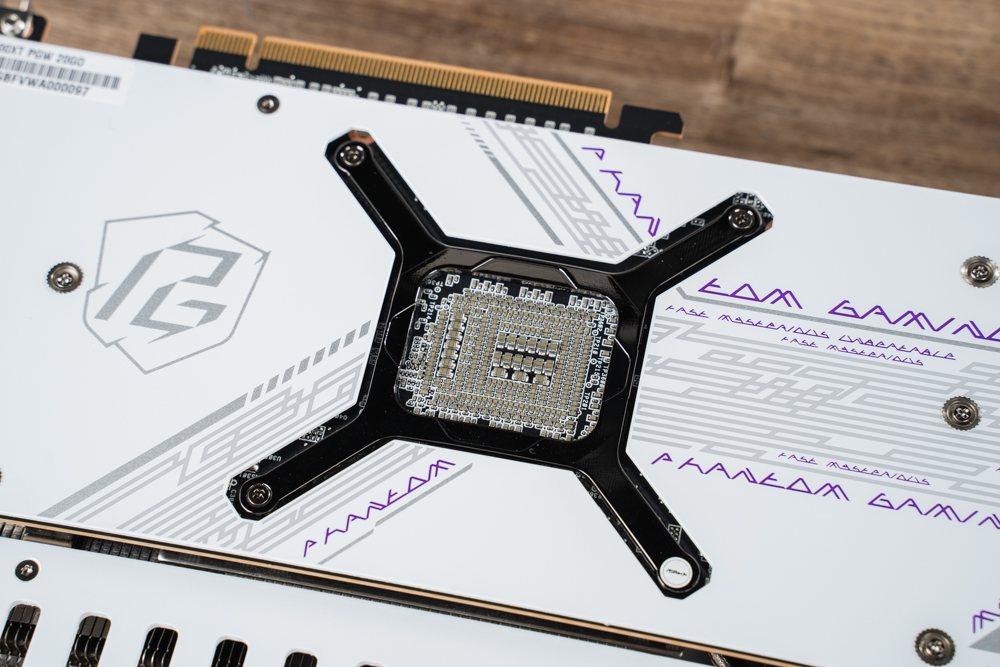
A detailed view of the ASRock RX 7900 XT Phantom Gaming White graphics card’s metal backplate. The backplate is an integral part of the card, serving several functions: it adds structural support, aids in cooling by dissipating heat, and provides aesthetic appeal with its clean, white finish and purple branding accents.
In the centre of the backplate is a cutout showcasing the GPU’s retention bracket and thermal pads, which indicates a focus on efficient heat transfer and management. This opening reveals the complexity of the card’s internal components and serves as a visual testament to the meticulous engineering behind the card’s design.
The Phantom Gaming logo is subtly imprinted on the backplate, reinforcing the brand identity. Around the edges, the purple text with the words “Phantom Gaming” repeats in a diagonal pattern, adding a pop of colour to the sleek design. This level of attention to detail in the card’s construction and appearance underscores its premium positioning in the market.
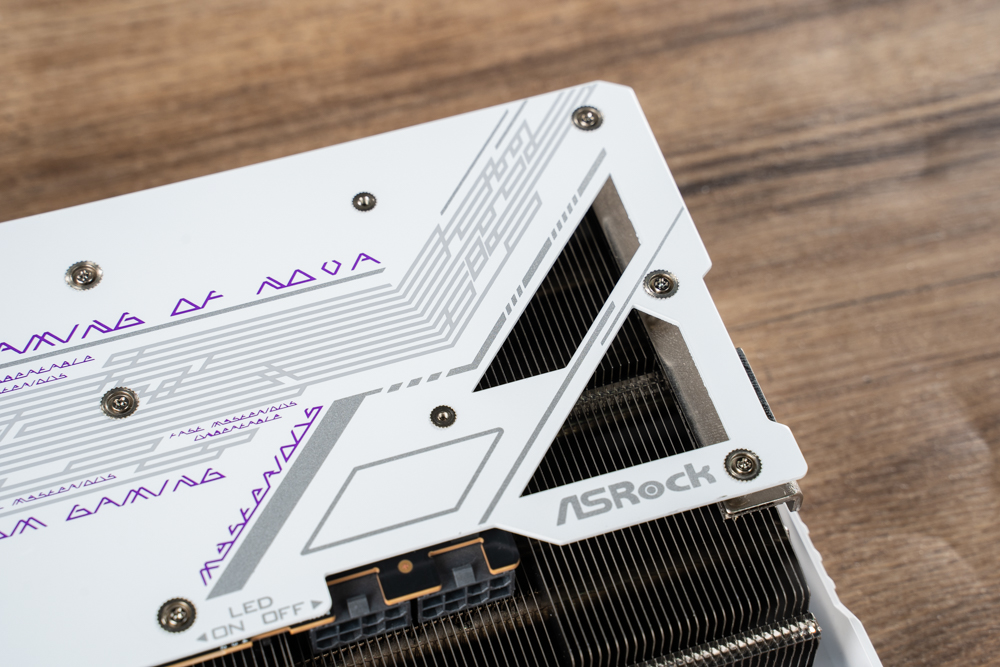
The image provides a closer look at the tail end of the ASRock RX 7900 XT Phantom Gaming White graphics card, featuring a strategically designed cutout that enhances air circulation. This open section on the backplate plays a crucial role in boosting convection cooling, allowing for hot air to escape and cooler air to enter the heatsink assembly beneath it, improving the thermal performance of the card.
The backplate itself is adorned with the repeated “Phantom Gaming” text in a striking purple hue, matched with angular patterns that give the card a sense of motion and aggressive styling befitting of a gaming-focused product. The prominent ASRock branding ensures that the manufacturer’s identity is clear, adding a touch of elegance with its placement and contrasting colour.
Notably, the image also includes a switch labelled ‘LED ON/OFF’, which allows users to easily control the lighting effects on the card. This feature is especially appreciated by users who prefer to customize their rig’s aesthetic or require a more subdued look at times.
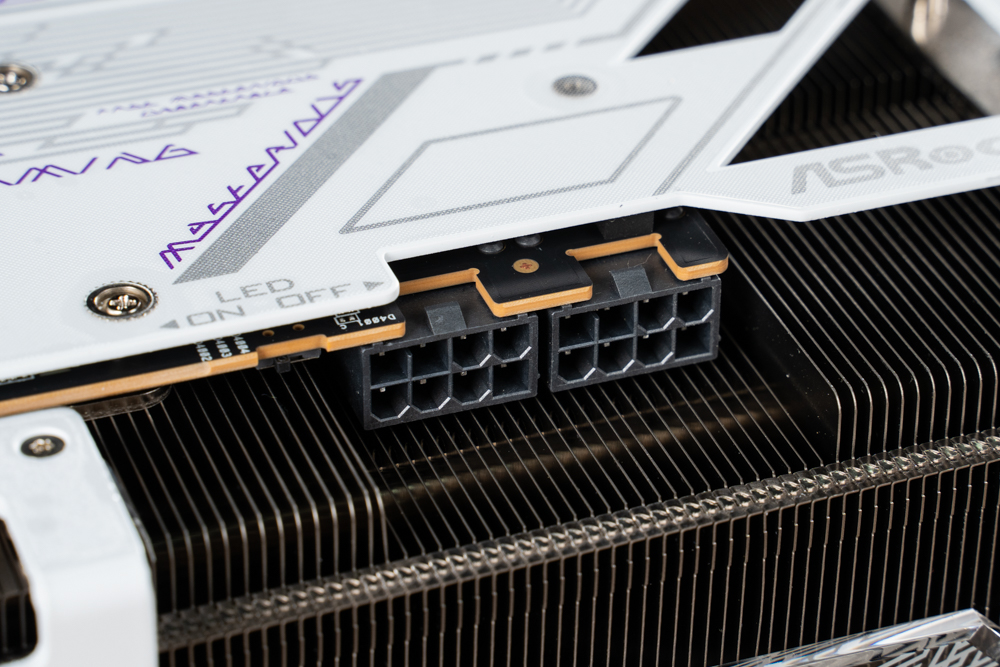
The image zooms in on the power supply section of the ASRock RX 7900 XT Phantom Gaming White graphics card, showing two PCIe 8-pin connectors. These connectors are essential for providing the substantial power that this high-end graphics card requires to operate, especially under heavy loads typical in gaming and intensive graphical tasks.
The absence of a 12VHPWR connector, a newer power connector standard, is noted; this card sticks with the tried-and-true PCIe 8-pin format, which is more common in power supplies and thus more accessible for a wide range of users.
Adjacent to the power connectors is the LED physical switch, which is a convenient feature for users who prefer manual control over their card’s lighting without needing software intervention. For those who enjoy synchronization and customization of their PC’s lighting, the card is also compatible with ASRock’s Polychrome SYNC, which allows for software control of lighting effects.
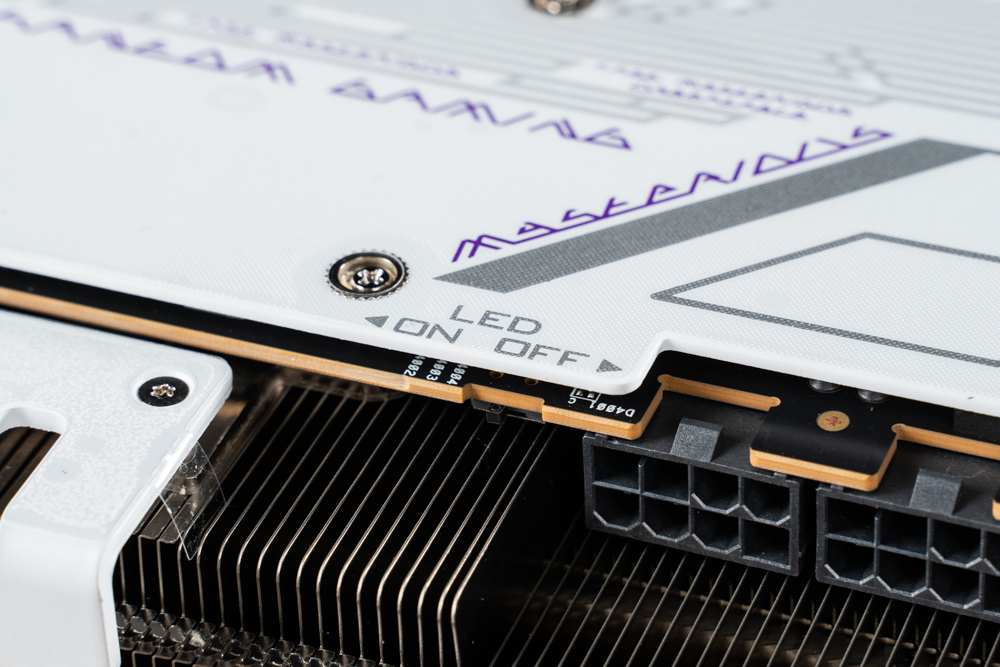
A detailed view of the LED switch on the ASRock RX 7900 XT Phantom Gaming White graphics card. This tiny but significant feature allows users to easily toggle the LED lighting on and off, providing a simple way to control the visual aspects of the card to suit their preference or to match the aesthetic of their gaming rig.
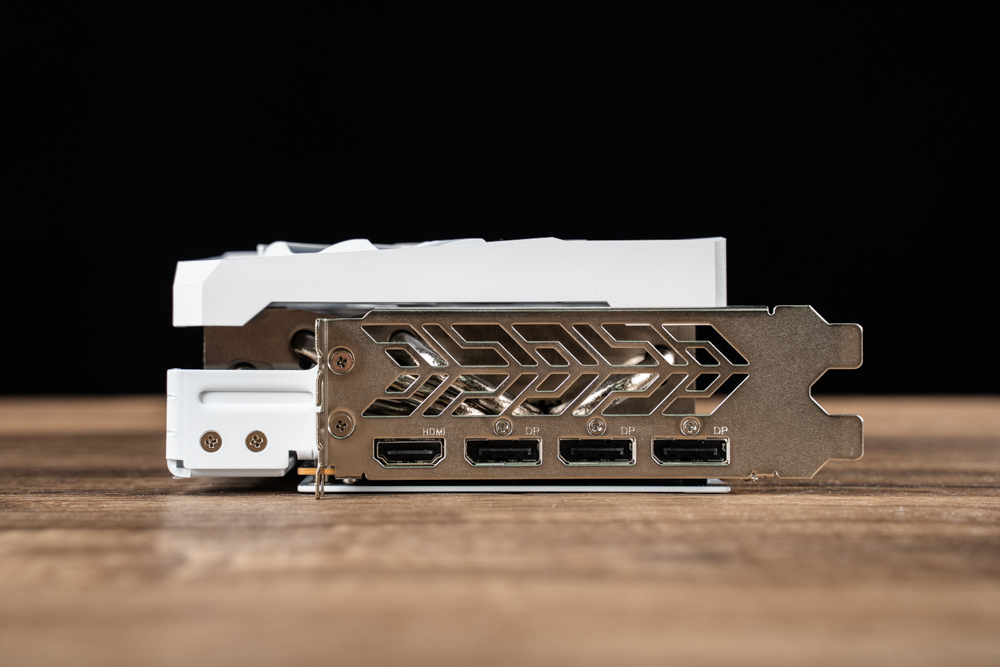
A clear view of the display output section of the ASRock RX 7900 XT Phantom Gaming White graphics card. The card features an array of output ports, including three DisplayPort (DP) 2.1 connectors and one HDMI 2.1a port, set against a stylish and sturdy-looking metal bracket.
The DisplayPort 2.1 specification is particularly noteworthy as it offers a significant bandwidth increase over the previous DP 1.4 standard, with a theoretical transfer rate of up to 80 Gbps, which is more than double. This advancement allows for higher resolutions, faster refresh rates, and better color depth on supported displays, which is especially important for gamers and professionals who require top-tier visual performance.
The HDMI 2.1a port also supports the latest features and resolutions, ensuring compatibility with a broad range of displays and multimedia devices. The bracket itself, with its intricate cut-out design, not only aids ventilation but also adds an aesthetic touch to the card’s overall design.
ASRock RX 7900 XT Phantom Gaming White Review: Advanced Cooling and Power for Enhanced Gaming
An open view of the ASRock RX 7900 XT Phantom Gaming White graphics card with its cooling module detached reveals the intricate layout of the PCB (Printed Circuit Board) and the components that power this advanced piece of hardware.
Central to the graphics card is the use of AMD’s RDNA 3 architecture with the NAVI 31 core. The GPU is composed of a 5nm GCD (Graphics Compute Die) accompanied by six 6nm MCDs (Memory Compute Dies), showcasing a complex multi-chip design that is at the forefront of modern graphics processing technology.
The card is fortified with second-generation ray tracing accelerators and AI accelerators, enhancing its capability to deliver high-fidelity graphics with advanced lighting effects and improved AI-driven processes. Each MCD includes 16MB of Infinity Cache, summing up to a total of 80MB, which is pivotal in widening the effective bandwidth for the GPU and thus reducing latency and improving performance.
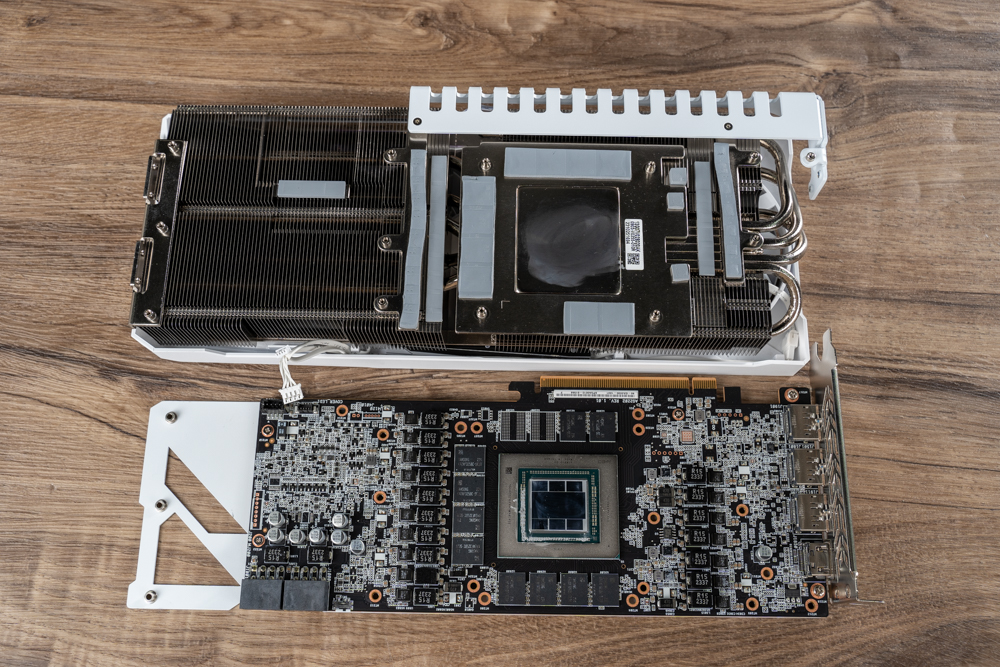
For memory, the card is outfitted with Samsung’s K4ZAF325BC-SC20 GDDR6 memory chips. With each chip having a capacity of 2GB, the card achieves a total memory size of 20GB. The memory clock reaches an impressive 20Gbps, contributing to the card’s high bandwidth and ensuring swift data transfer rates, which are essential for handling high-resolution textures and maintaining performance at higher resolutions.
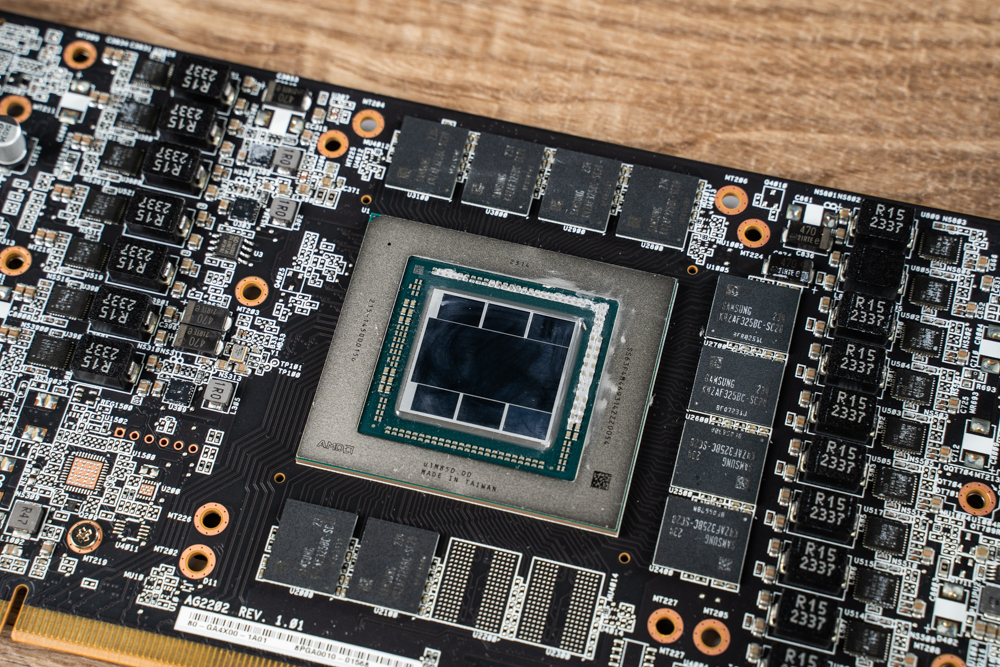
A close-up view of the PCB of the ASRock RX 7900 XT Phantom Gaming White graphics card, highlighting the AMD NAVI 31 core, which is the central processing unit of the card, and the ten GDDR6 memory modules surrounding it.
The NAVI 31 GPU is at the heart, based on the advanced RDNA 3 architecture, designed to deliver high-end gaming performance, efficiency, and cutting-edge features like ray tracing and AI-enhanced graphics. The memory modules, which appear to be from Samsung, are integral in providing the graphics card with a total of 20GB of memory, allowing for large datasets to be stored, such as textures in gaming or in graphically-intensive applications.
The visual presentation of the core and memory modules is a testament to the intricate design and engineering that goes into modern graphics cards. It also emphasizes the card’s capabilities for handling demanding tasks, providing ample memory for high-resolution gaming, detailed digital content creation, and other GPU-intensive tasks.
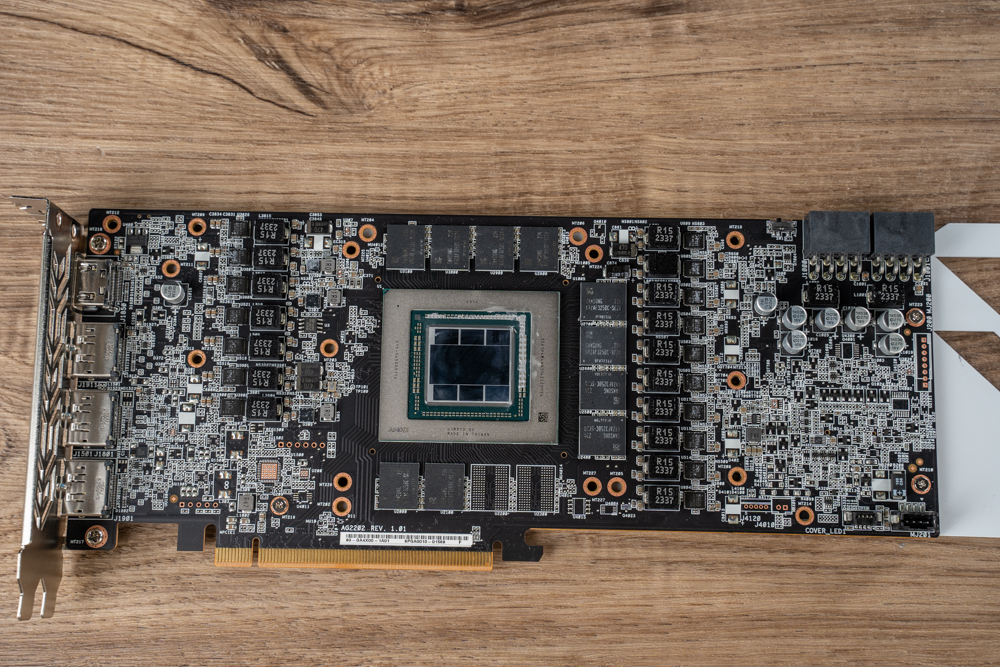
A detailed view of the Printed Circuit Board (PCB) of the ASRock RX 7900 XT Phantom Gaming White graphics card, highlighting its intricate and dense layout. The card employs a sophisticated 14+3 phase power delivery system designed to provide stable and efficient power to the GPU and memory, essential for maintaining performance under various load conditions.
The tightly packed components indicate a complex electrical design to maximize the PCB real estate. This kind of design indicates the card’s high-end status, intended to deliver reliable performance for gaming and compute-intensive tasks. Using an MPS MP2857 controller chip for the core and an MPS MP2856 for the memory emphasizes the card’s focus on quality and durability. Each phase of the power delivery uses MP87997 70A DrMOS, which are likely to be high-efficiency, high-current power stages that contribute to the overall stability and overclocking potential of the card.
Notably, even some control chips are placed on the back of the PCB, a decision that’s possibly made to optimize the layout for thermal performance and space management. Such detailed engineering is crucial in high-performance components where heat dissipation and power management are key to maintaining the longevity and performance of the device.
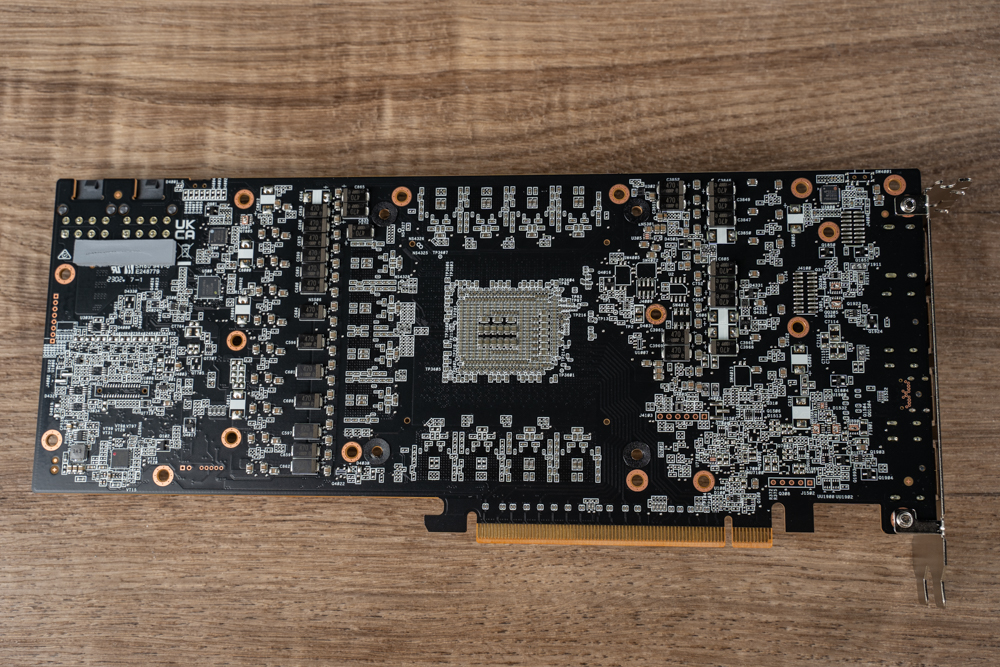
The backside of the ASRock RX 7900 XT Phantom Gaming White graphics card’s PCB. This view gives insight into the meticulous layout and the sheer number of components that contribute to the card’s functionality. Notably absent are the bulky components found on the front side, making the back relatively flat, which is often crucial for installing third-party cooling solutions or maintaining a low profile for better case compatibility.
The back is peppered with an array of surface-mounted devices, such as capacitors and resistors, all of which are integral to the graphics card’s operation. The positioning of these components is carefully planned to ensure optimal electrical paths and to manage power distribution and signal integrity across the PCB.
The copper-coloured screws mark the points where the GPU, VRAM, and VRMs are located on the opposite side, reflecting where the thermal pads or heatsink would make contact for heat dissipation. The cleanliness of the PCB and the use of what appears to be a black solder mask give the card a sleek look, while the copper vias (visible as small copper rings) accentuate the card’s high-quality manufacturing process.
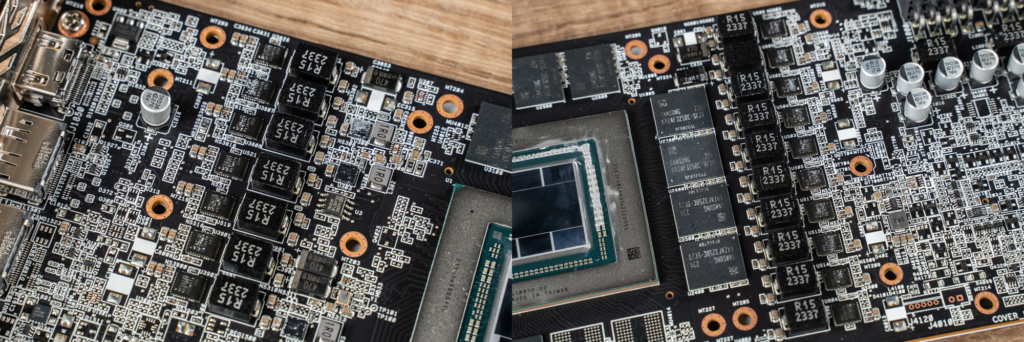
The ASRock RX 7900 XT Phantom Gaming White graphics card’s PCB gives us a closer look at the comprehensive 14+3 phase power delivery system. The 14+3 phase refers to the VRM (Voltage Regulator Module) configuration, with 14 phases dedicated to the GPU (VCore) and 3 phases for the memory (VMem), ensuring precise power control and delivery for stable overclocking and performance.
The left side of the image reveals the tightly packed power stages and chokes, which are part of the VRM responsible for converting the power from the PSU (Power Supply Unit) to the voltages required by the GPU and memory. This high phase count generally translates to smoother power delivery, and better thermal performance due to load distribution across multiple phases, and can contribute to the longevity of the components.
In the middle, the GPU die is surrounded by its associated power delivery components, and to the right, we see the memory phases, along with the Samsung GDDR6 memory modules mentioned earlier.
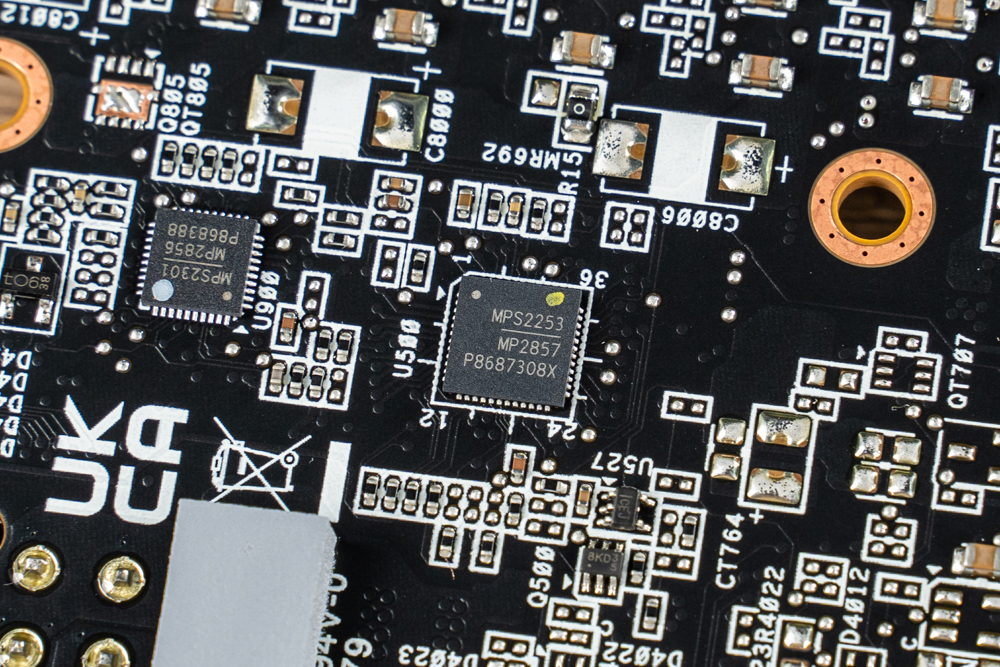
A specific area of the ASRock RX 7900 XT Phantom Gaming White graphics card’s PCB, highlights the MPS MP2857 controller chip. This chip is a critical component of the power delivery system, tasked with managing the voltage regulation for the GPU. The presence of a dedicated controller like the MP2857 indicates a focus on providing stable and efficient power management, which is especially important for high-performance graphics cards that are often subjected to heavy workloads.
The surrounding area is populated with various other components such as capacitors, resistors, and possibly other power stages, all of which play a role in the delivery and stabilization of power to the GPU. This meticulous arrangement of high-quality components is key to achieving the overclocking stability and performance headroom enthusiasts and gamers seek.
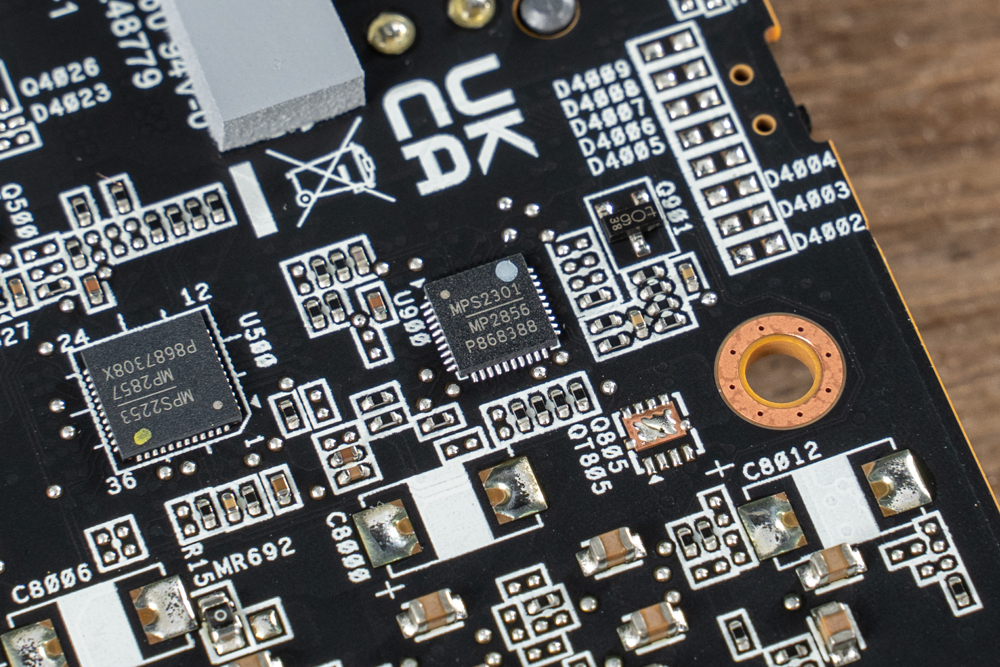
A close-up of the MPS MP2856 controller chip located on the PCB of the ASRock RX 7900 XT Phantom Gaming White graphics card. The MP2856 is integral to the card’s power delivery system, specifically tasked with managing and regulating the power for the memory components.
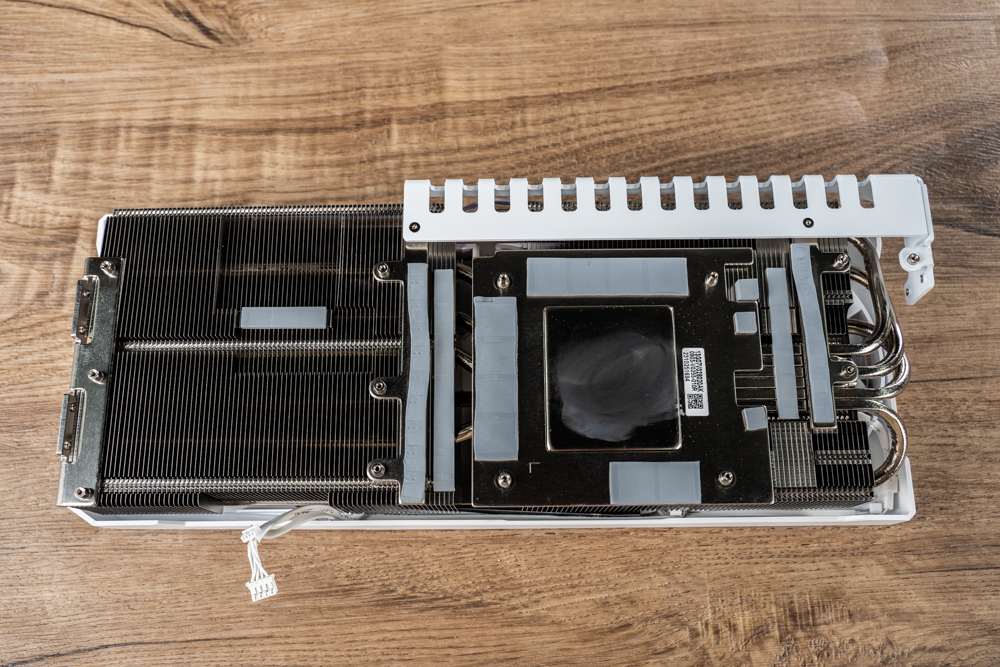
The ASRock RX 7900 XT Phantom Gaming White graphics card’s cooling module, a vital component for maintaining optimal operating temperatures during intense gaming sessions or heavy workloads. The module is designed with six heat pipes that facilitate the transfer of heat away from the GPU and VRAM. These pipes are paired with a nickel-plated copper base that maximizes contact area for efficient heat absorption.
The unique V-shaped notches and vent designs are part of the card’s exclusive strategy to guide airflow more effectively through the heatsink, which is critical for enhancing cooling efficiency. This careful design helps to direct air across the heat pipes and fins, ensuring that the heat is dissipated quickly and efficiently.
As mentioned, the inclusion of thermal pads on both the front and back of the card indicates a thorough approach to thermal management. These pads ensure that not only the primary heat-generating components but also surrounding areas are covered, contributing to a more comprehensive cooling solution.
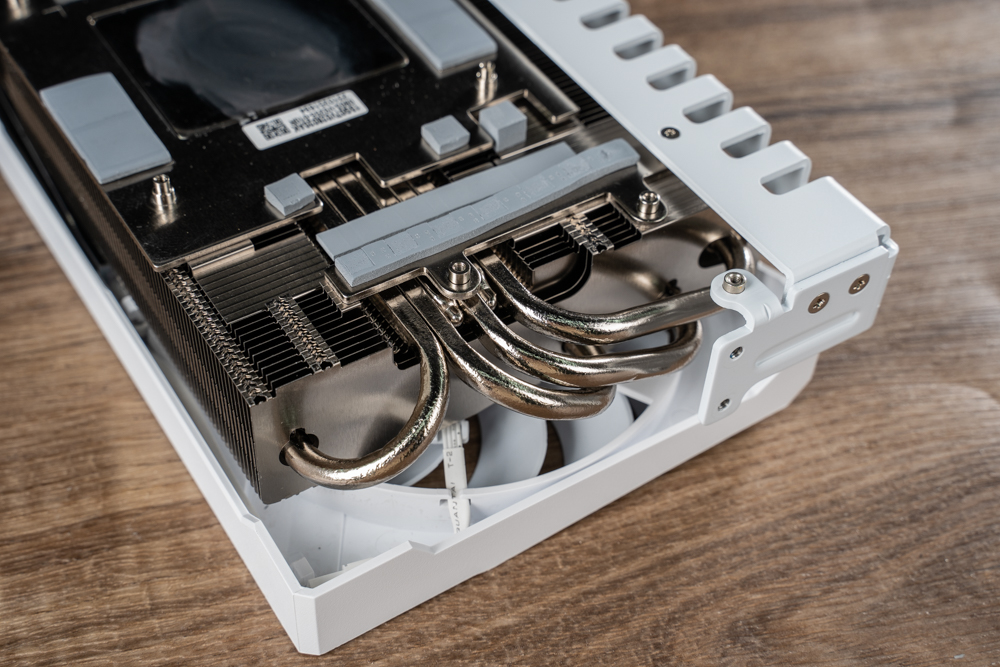
A close-up of the six copper heat pipes within the cooling system of the ASRock RX 7900 XT Phantom Gaming White graphics card. These heat pipes are designed to efficiently transfer heat away from the GPU core to the fin stack where it can be dissipated by the airflow from the fans.
The curvature of the heat pipes indicates they are engineered to maximize the surface area in contact with the heatsink, enhancing the thermal transfer capabilities. The copper material is chosen for its excellent thermal conductivity properties, which is essential for high-performance cooling solutions like this one.
The heat pipes’ placement and their integration into the heatsink are crucial for the cooling performance of the graphics card, ensuring it can maintain optimal temperatures even under heavy loads. This aspect of the design is particularly appealing to gamers and professionals who push their hardware to the limits and require stable performance.
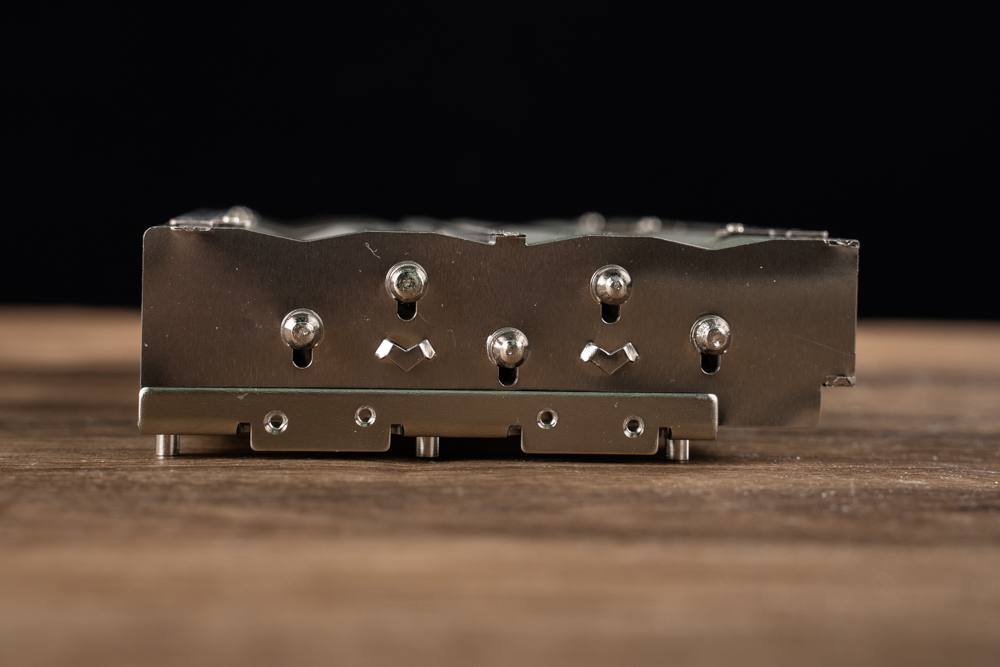
A detailed look at the innovative V-shaped notches and air vent design on the side of the ASRock RX 7900 XT Phantom Gaming White graphics card’s heatsink. These V-shaped cuts are engineered to optimize airflow through the heatsink, thereby improving the thermal performance of the cooling system.
The way the notches are positioned allows for air to flow more dynamically across the surface of the heatsink, helping to increase the dissipation of heat from the heat pipes and fins. This kind of aerodynamic feature is critical in high-performance cooling solutions, as it can significantly enhance the efficiency of heat transfer from the hardware to the air expelled by the system’s fans.
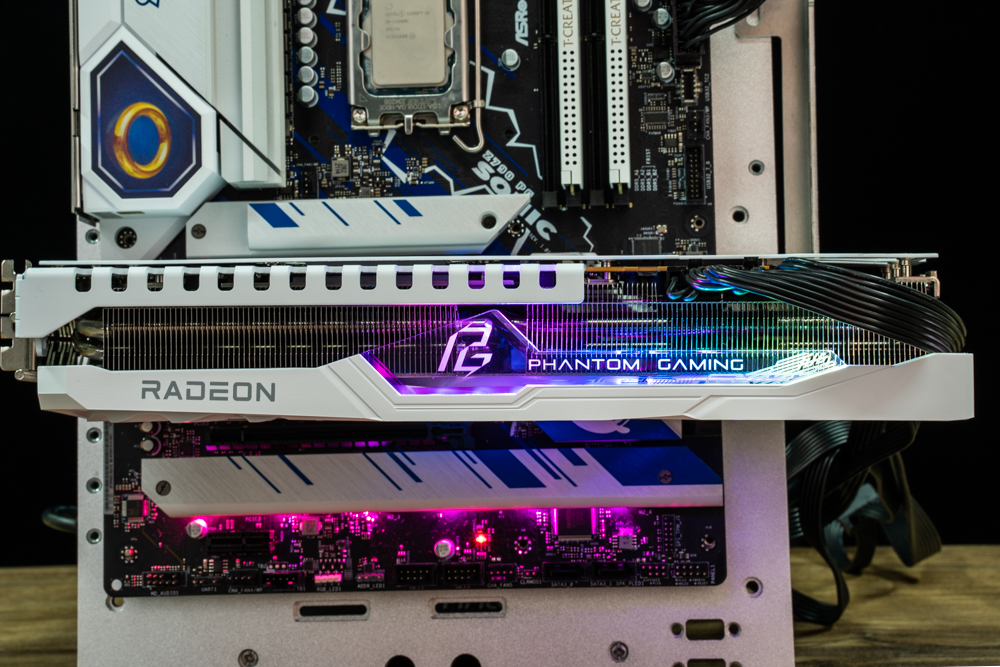
The ASRock RX 7900 XT Phantom Gaming White graphics card is installed in a system, displaying its side illumination effects. The RGB lighting prominently features the Phantom Gaming logo and accentuates the card’s sleek design with a captivating array of colours that add to the overall aesthetic of the gaming setup.
The lighting not only highlights the branding but also enhances the visual appeal of the card within the case, which is a desirable feature for many gamers who take pride in their system’s appearance. The Radeon branding is also illuminated, reaffirming the card’s identity and its high-performance AMD GPU.
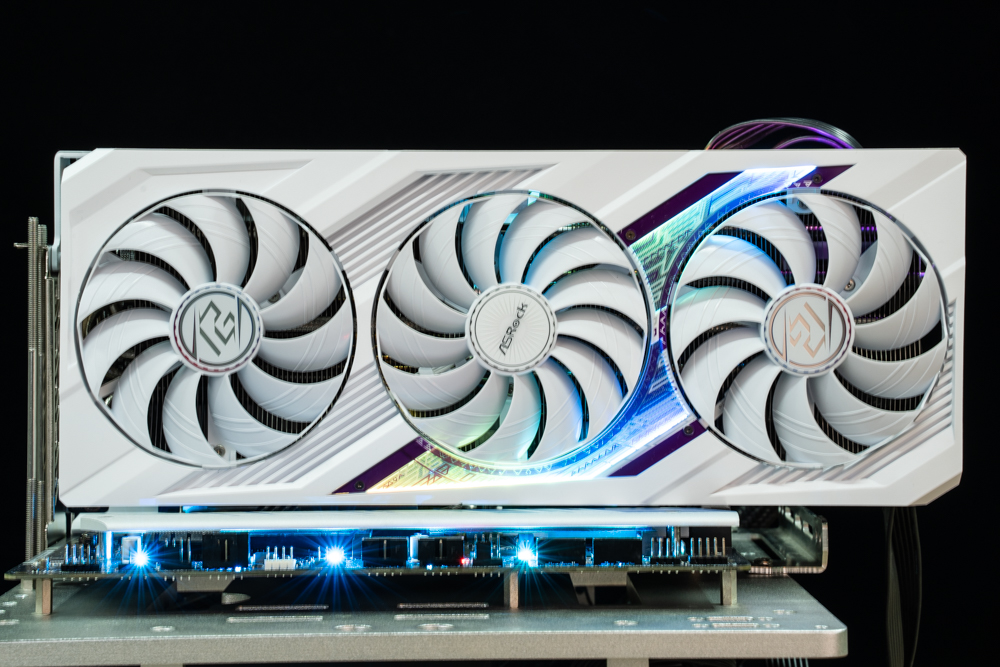
A frontal view of the ASRock RX 7900 XT Phantom Gaming White graphics card, prominently showcasing its aesthetic RGB lighting effects. The three fans are adorned with the Phantom Gaming logo, and the lighting adds a dynamic visual element to the card’s white and silver design. The RGB lights create a captivating visual effect that reflects off the intricate fan blades and through the semi-transparent fan housing.
This feature is particularly appealing to users who appreciate a customizable PC build, as the lighting can often be adjusted to match personal tastes or to synchronize with other RGB components within a system. The illumination gives the card a standout presence in any gaming setup and contributes to the overall immersive experience.
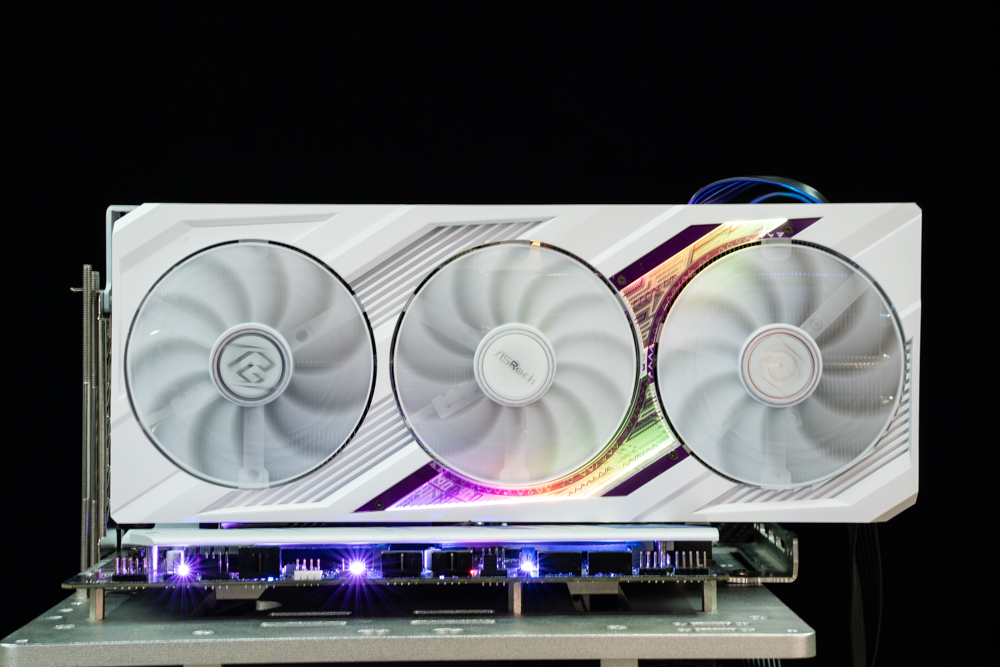
The ASRock RX 7900 XT Phantom Gaming White graphics card is in action, featuring its front-facing RGB lighting effects. The fans are spinning, which creates a blur effect that, along with the RGB lighting, gives a sense of motion and energy. The light streaks through the semi-transparent fan blades and the striped accents on the shroud, showcasing the card’s dynamic and modern design.
The RGB lighting, which seems to span the cooling shroud’s length, brings life to the card and adds an attractive element that can be seen through a case’s transparent side panel. This enhances the overall visual experience for users who enjoy a personalized and vibrant PC setup.
Maximizing Gaming and Rendering Performance: ASRock RX 7900 XT Phantom Gaming White Benchmarks Revealed
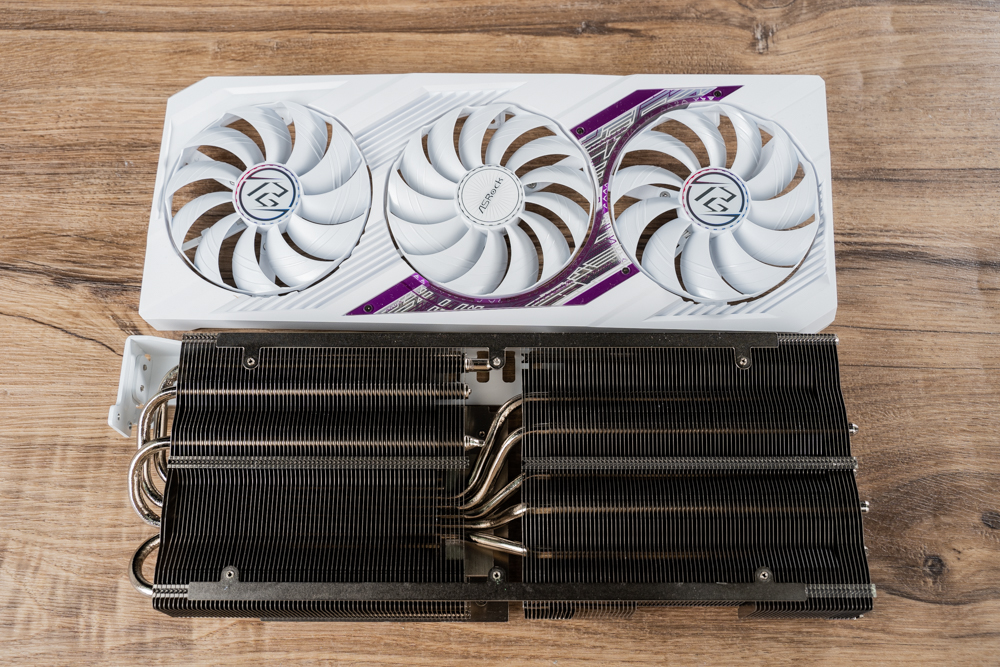
This GPU-Z screenshot provides technical information about the ASRock RX 7900 XT Phantom Gaming White 20GB OC graphics card.
- The GPU core is the Navi 31, utilizing 5nm technology with a die size of 306 mm² and featuring 57700 million transistors.
- The graphics card was released on November 3, 2022.
- It has 5376 Unified Shaders, a pixel fillrate of 470.2 GPixels/s, and a texture fillrate of 822.9 GTexels/s.
- The memory type is GDDR6 (Samsung), with a size of 20480 MB and a 320-bit bus width. It boasts an impressive bandwidth of 800.0 GB/s.
- The GPU clock runs at a base frequency of 2075 MHz and a boost frequency of 2449 MHz, operating over a PCIe 4.0 x16 bus interface.
- The card has a Total Graphics Power (TGP) of 320W.
The test platform’s specifications are also high-end, featuring an Intel Core i9-14900K processor, an ASUS ROG Strix Z790-E GAMING WIFI II motherboard, 48GB of T-Force Delta RGB DDR5-7200 memory, CORSAIR MP600 PRO LPX 1TB + CORSAIR MP400 4TB storage solutions, a Lian Li Galahad II PERFORMANCE 360 cooler, a SUPER FLOWER LEADEX VII 1000W power supply, and running on Windows 11 Pro 23H2 with Adrenalin driver version 24.2.1.
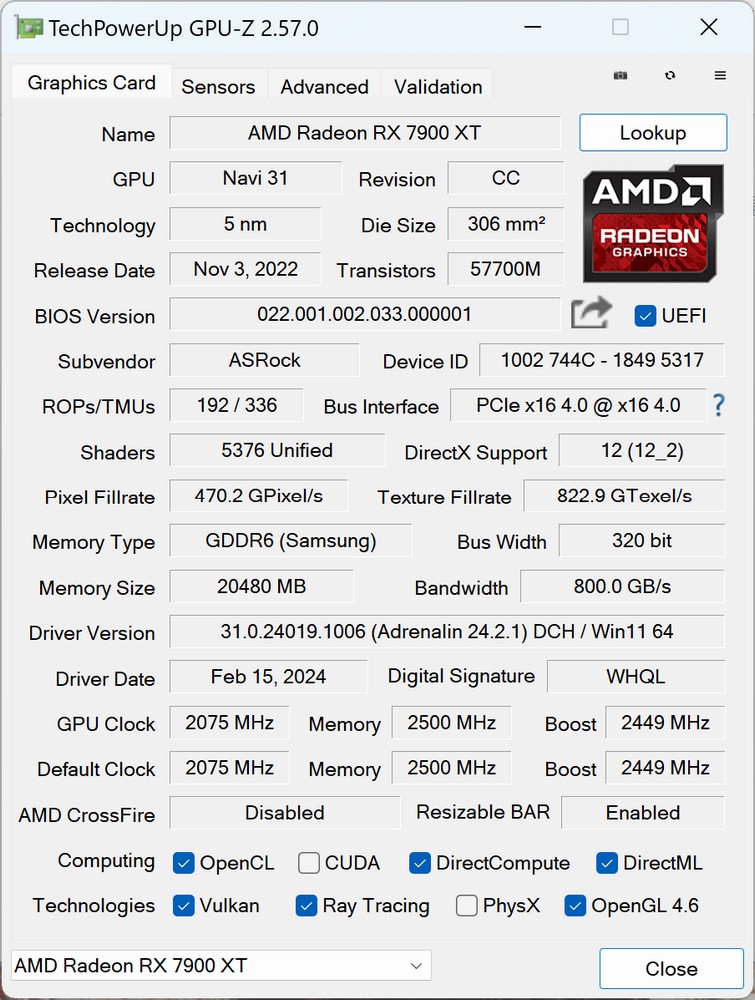
This setup is indicative of a top-tier gaming or workstation build, optimized for high performance and capable of handling the most demanding applications and games with ease. The ASRock RX 7900 XT Phantom Gaming White, with its high boost clock and substantial memory capacity, would be a key player in achieving exceptional graphics performance in such a system.
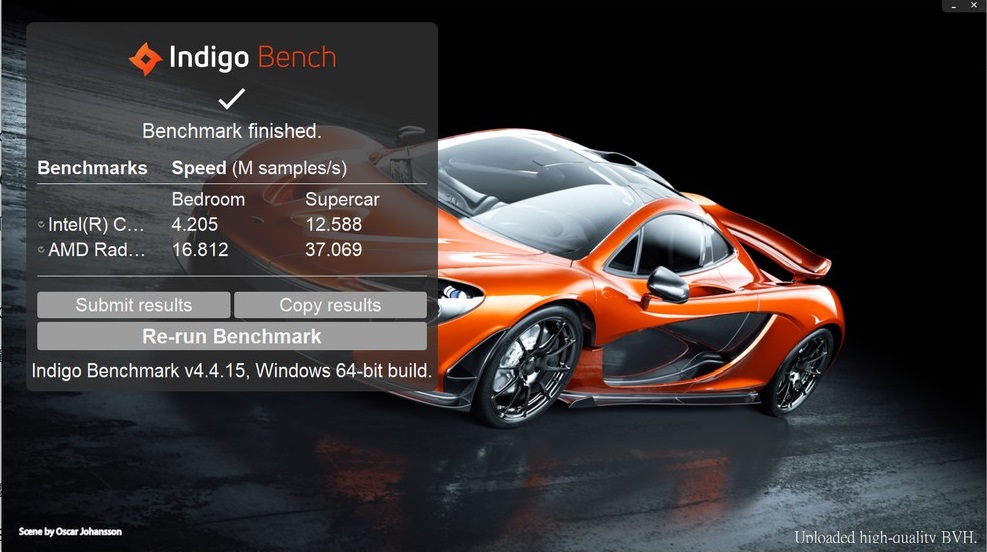
The results from running Indigo Bench, a benchmarking software based on the Indigo 4 rendering engine, which uses the OpenCL framework. This benchmark is capable of evaluating the performance of a variety of graphics cards, including those from AMD, NVIDIA, and Intel.
The benchmarking tool has two sample tests, ‘Bedroom’ and ‘Supercar’, designed to push the graphics card to render complex scenes. The performance is measured in millions of samples per second (M samples/s), with higher scores indicating better rendering performance.
In this benchmark, the ASRock RX 7900 XT Phantom Gaming graphics card has achieved a score of 16.812 samples/s for the ‘Bedroom’ test and 37.069 samples/s for the ‘Supercar’ test. These scores are quite impressive, suggesting that the RX 7900 XT Phantom Gaming is capable of handling demanding rendering tasks with high efficiency.
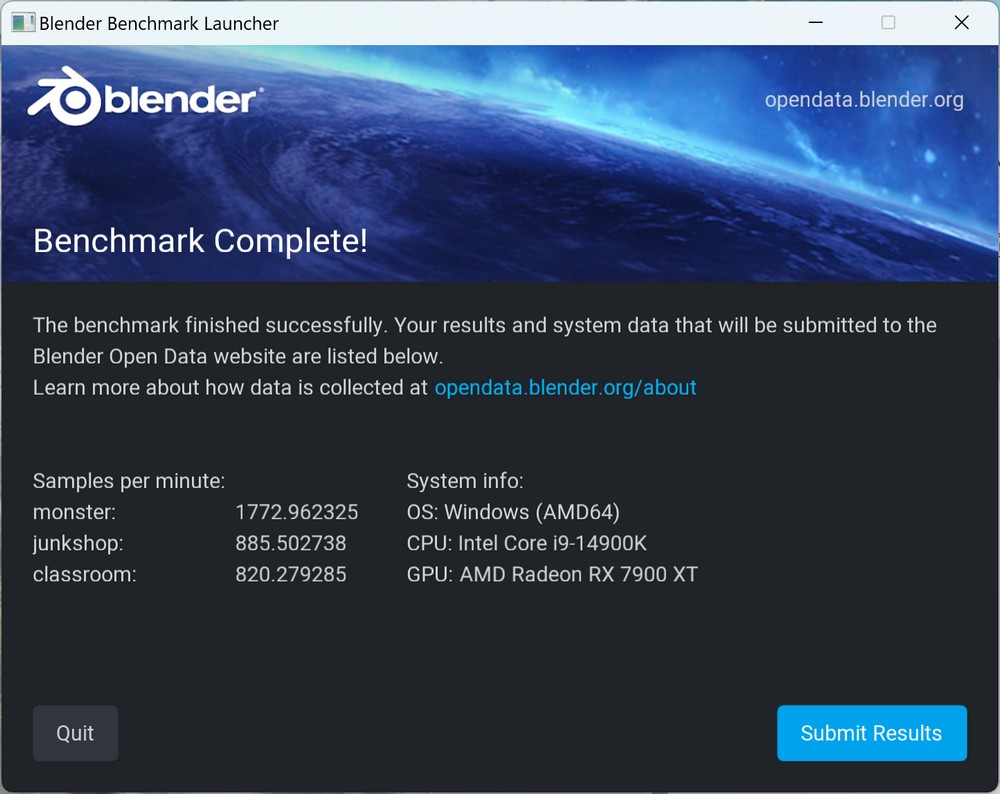
From the Blender Benchmark Launcher shows the results of a performance test for 3D rendering using the free benchmarking tool provided by the 3D graphics software Blender. The benchmark provides three different scenes — monster, junkshop, and classroom — to assess the rendering speed of either CPU or GPU.
In this case, the ASRock RX 7900 XT Phantom Gaming graphics card has achieved the following scores:
- Monster: 1772.96 samples per minute
- Junkshop: 885.50 samples per minute
- Classroom: 820.27 samples per minute
These results indicate the card’s robust performance in 3D rendering tasks, with higher scores correlating to faster-rendering capabilities. This is particularly relevant for professionals and enthusiasts in fields such as 3D animation, visual effects, game development, and architectural visualization, who rely on GPU performance for efficient workflow.
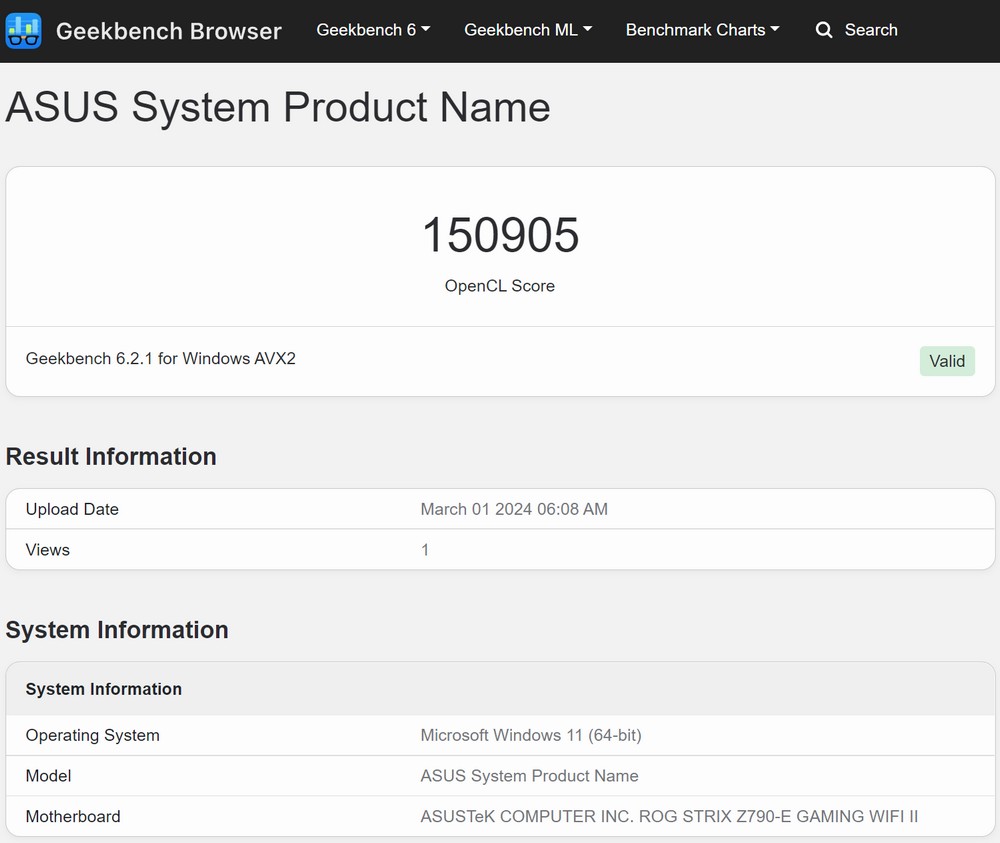
The provided Geekbench Browser screenshot shows the OpenCL performance score for an ASUS system, which is typically reflective of the performance of the graphics card within that system, especially in compute-oriented tasks. OpenCL (Open Computing Language) scores in Geekbench measure the GPU’s capability to handle parallel computations, which is vital for tasks such as image processing, rendering, and machine learning.
The system information indicates that the setup includes an ASUS motherboard (ROG STRIX Z790-E GAMING WIFI II) and is running Microsoft Windows 11. While the graphics card model is not directly mentioned in this screenshot, it’s mentioned in the accompanying text that the ASRock RX 7900 XT Phantom Gaming graphics card scored 150,905 in the OpenCL test and 212,100 in the Vulkan API test within Geekbench 6.
The Vulkan API score is also relevant, as Vulkan is a modern cross-platform graphics and compute API that offers high efficiency and performance. A higher score in Vulkan indicates better performance in games and applications that utilize this API for rendering and compute operations.
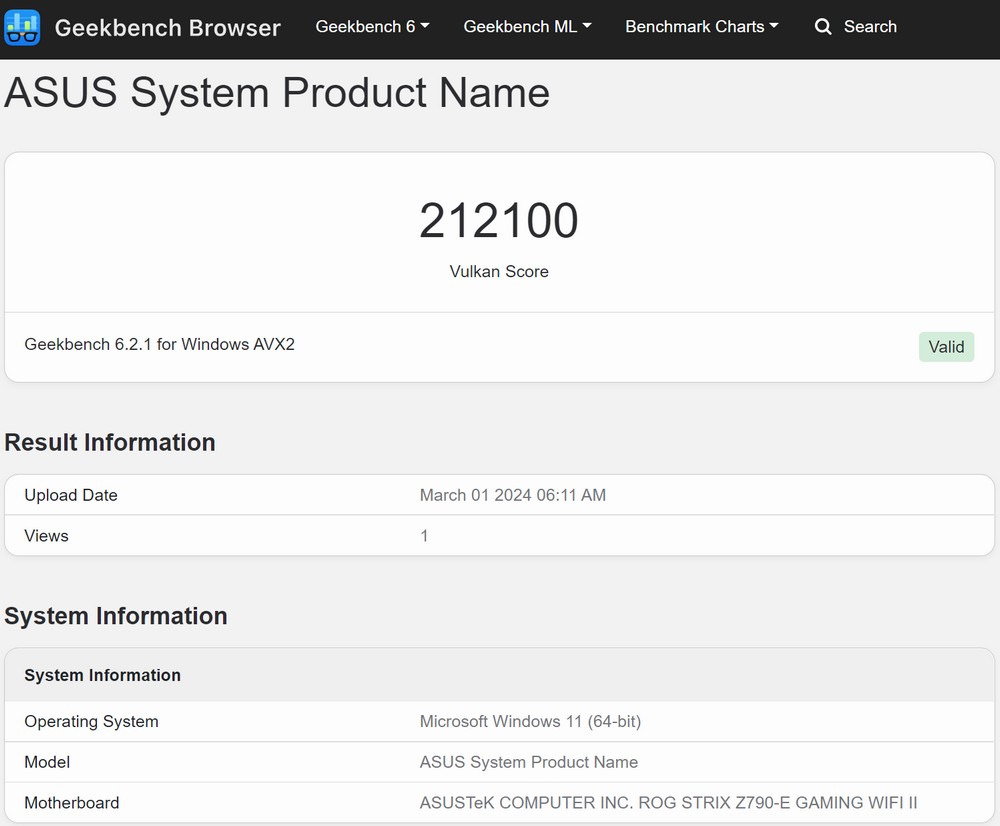
From the Geekbench Browser indicates a Vulkan performance score of 212,100. Vulkan is another modern API that provides high-efficiency, cross-platform access to modern GPUs used in a wide variety of devices from PCs and consoles to mobile phones. This particular score pertains to a system equipped with an ASUS motherboard model ROG STRIX Z790-E GAMING WIFI II, running on Microsoft Windows 11.
ASRock RX 7900 XT Phantom Gaming White Shines in 3DMark Benchmarks: A Deep Dive into Gaming Performance
3DMark is indeed a widely recognized benchmarking software for assessing gaming performance, and it offers a variety of tests tailored to different graphics APIs, resolutions, and features like ray tracing and AMD’s FSR (FidelityFX Super Resolution).
The scores you’ve mentioned for the ASRock RX 7900 XT Phantom Gaming in 3DMark’s Fire Strike benchmarks are quite telling of the card’s performance capabilities:
- In the standard Fire Strike test, which is rendered at 1080p resolution using DirectX 11, the RX 7900 XT Phantom Gaming scored an impressive 60,370 in the graphics performance category.
- In Fire Strike Extreme, which ups the resolution to 2K, the graphics score achieved by the card was 33,615.
- And in Fire Strike Ultra, which tests the card’s ability to handle gaming at a demanding 4K resolution, the score was 17,132.
These results indicate that the RX 7900 XT Phantom Gaming card is well-suited for high-resolution gaming and can deliver excellent performance even in more demanding scenarios such as 2K and 4K. The scores demonstrate the card’s prowess in handling complex graphical computations and its readiness for current AAA gaming titles that make use of DirectX 11.
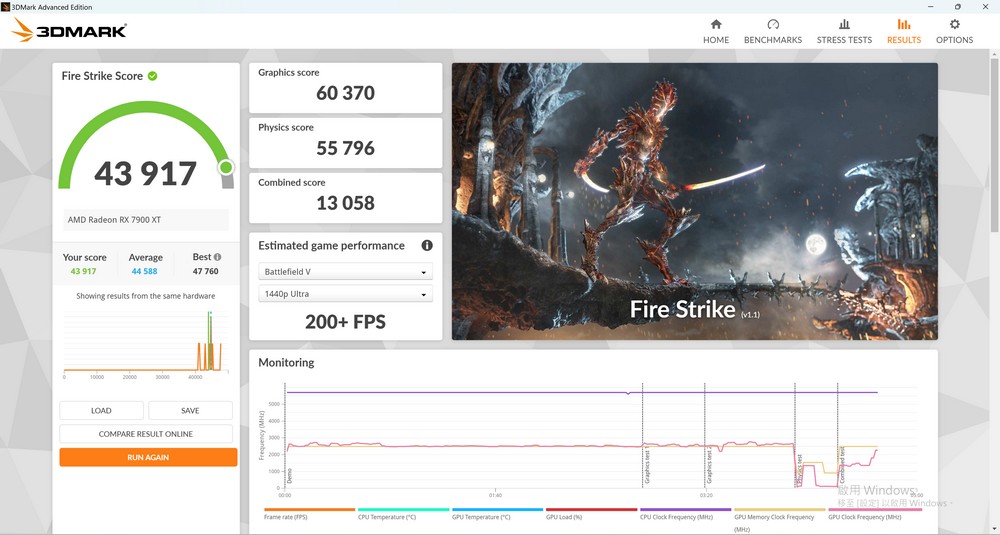
From 3DMark’s Fire Strike benchmark shows the performance results of an AMD Radeon RX 7900 XT graphics card. The overall Fire Strike score is 43,917, with the detailed scores as follows:
- Graphics score: 60,370
- Physics score: 55,796
- Combined score: 13,058
These scores, especially the graphics score, underscore the GPU’s capability to handle the intense demands of the Fire Strike benchmark, which simulates the load and performance in gaming at 1080p. The physics score reflects CPU performance in physics simulations, and the combined score represents both GPU and CPU working together in a mixed workload scenario.
The estimated game performance suggests that on this system, one could expect 200+ FPS in Battlefield V at 1440p Ultra settings, which is a high level of performance, demonstrating that this GPU is well-suited for competitive gaming at high frame rates and resolutions.
The monitoring section of the image provides real-time data on frame rates and temperatures for the CPU and GPU during the benchmark, indicating stable performance without any thermal throttling.
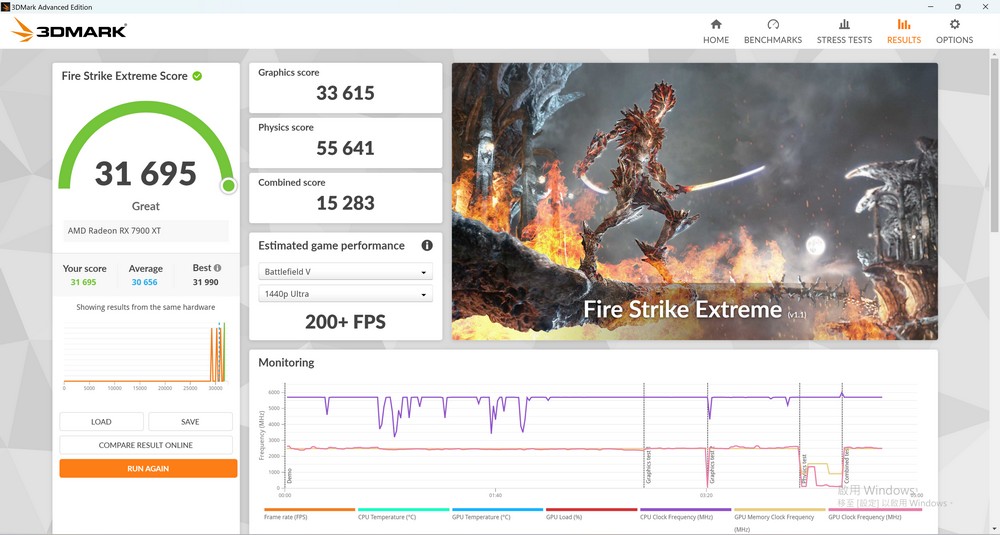
The 3DMark Fire Strike Extreme benchmark results for an AMD Radeon RX 7900 XT graphics card. The Fire Strike Extreme benchmark is a more demanding test than the standard Fire Strike, designed to evaluate the performance of the graphics card at a higher 2K resolution. The scores indicated are:
- Overall Fire Strike Extreme Score: 31,695
- Graphics Score: 33,615
- Physics Score: 55,641
- Combined Score: 15,283
These results show that the AMD Radeon RX 7900 XT performs exceptionally well at higher resolutions, maintaining high-performance levels even under more intensive graphical loads. The consistent physics score between this and the standard Fire Strike indicates a stable CPU performance, while the combined score suggests that both the CPU and GPU coordinate well under mixed workloads.
The estimated game performance also remains impressive, with an estimation of 200+ FPS for Battlefield V at 1440p Ultra settings. Such performance demonstrates that the card is quite capable of running current AAA games at high resolutions and settings without compromising on frame rates.
In the monitoring section, the graph displays the stability of frame rates, as well as the temperatures of both the CPU and GPU throughout the benchmark, showing no significant thermal throttling and underscoring the efficacy of the card’s cooling solution.
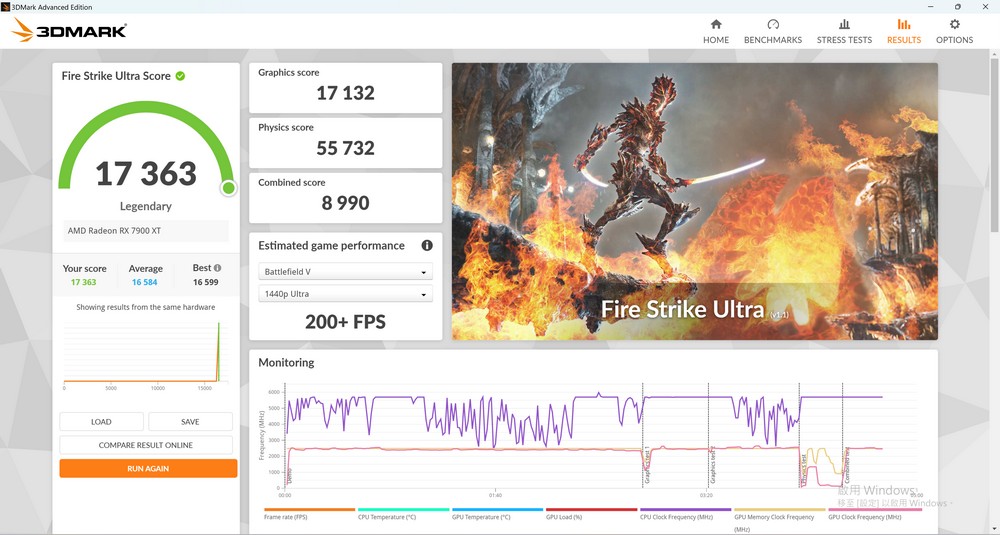
We see the 3DMark Fire Strike Ultra benchmark results for an AMD Radeon RX 7900 XT graphics card. This benchmark is designed to push graphics cards to their limits by rendering at 4K UHD resolution, providing a sense of how the hardware might handle the most graphically intense scenarios.
The key scores from this Fire Strike Ultra benchmark are:
- Overall Fire Strike Ultra Score: 17,363
- Graphics Score: 17,132
- Physics Score: 55,732
- Combined Score: 8,990
These scores indicate that the AMD Radeon RX 7900 XT is capable of holding its ground even at the demanding 4K resolution, offering excellent graphical fidelity in ultra-high-definition gaming. The high physics score also speaks to the strong performance of the CPU, while the combined score suggests good synergy between the CPU and GPU when working together on tasks that demand both computing and graphics power.
The estimated game performance still indicates more than 200 FPS on Battlefield V at 1440p Ultra settings, suggesting that for games at 4K or lower resolutions, this card can provide a smooth and immersive gaming experience with high detail settings.
Monitoring graphs in the bottom section show the stability of the frame rate and the temperatures for the CPU and GPU throughout the benchmark run. These help to confirm that the system is well-cooled and that the graphics card is capable of maintaining its performance without thermal throttling affecting the outcome.
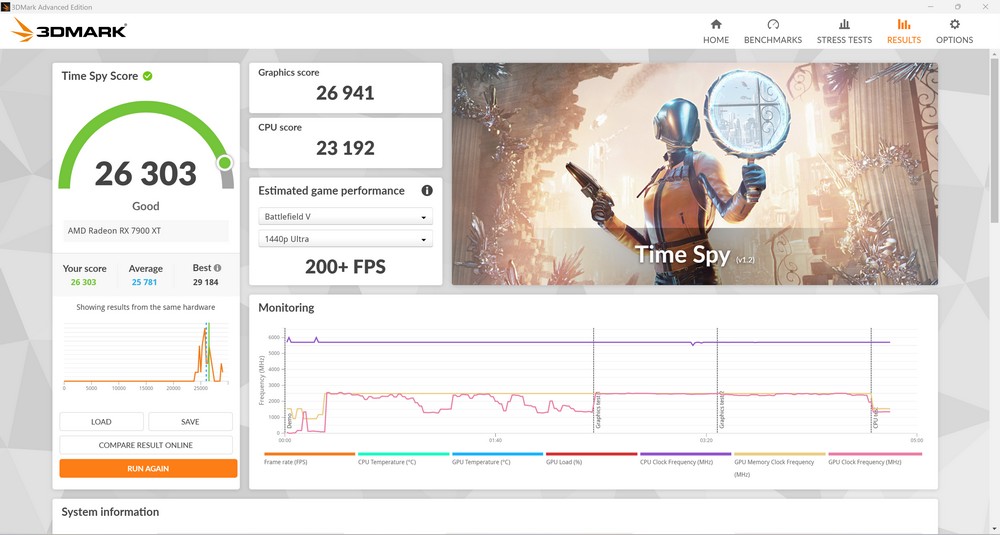
The results from the 3DMark Time Spy benchmark, which is designed to assess the performance of a system’s graphics card using the DirectX 12 API at 2K resolution. The scores for the AMD Radeon RX 7900 XT indicate strong performance:
- Overall Time Spy Score: 26,303
- Graphics Score: 26,941
- CPU Score: 23,192
These scores suggest that the AMD Radeon RX 7900 XT provides excellent performance under the DirectX 12 API, which is known for its efficient handling of modern gaming workloads and improved CPU utilization through features like asynchronous computing.
The estimated game performance is also noteworthy, indicating more than 200 FPS in Battlefield V at 1440p Ultra settings. This suggests that gamers can expect smooth and responsive gameplay at high graphical settings.
The Time Spy Extreme score, which is not shown in this image but mentioned in your text, is 12,900. Time Spy Extreme is a more demanding version of the test, rendering at 4K resolution. A score of 12,900 in Time Spy Extreme indicates that the RX 7900 XT Phantom Gaming can also handle 4K gaming with competence, although not as easily as it handles 2K.
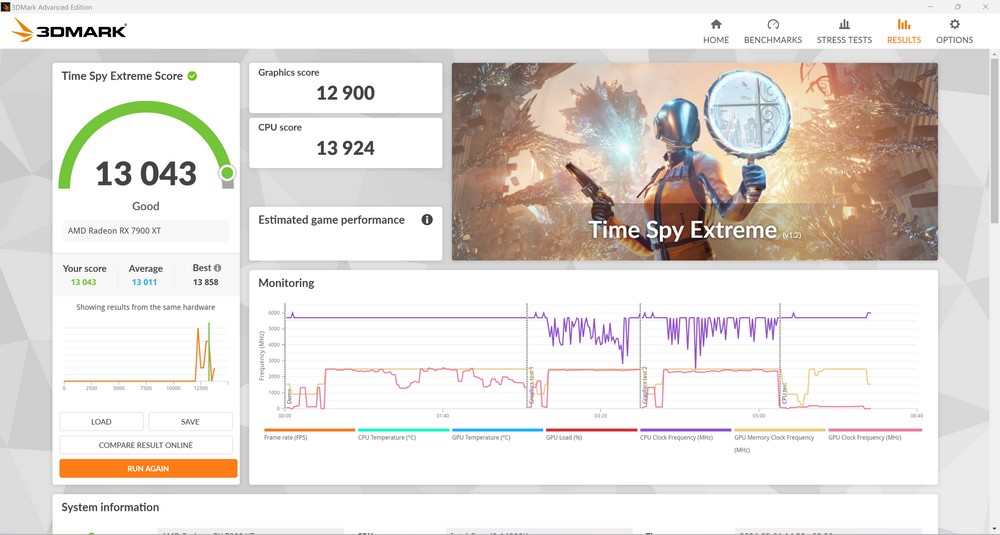
The results of the 3DMark Time Spy Extreme benchmark for an AMD Radeon RX 7900 XT graphics card. Time Spy Extreme is a more strenuous test designed to assess DirectX 12 performance at 4K resolution. The key scores are:
- Overall Time Spy Extreme Score: 13,043
- Graphics Score: 12,900
- CPU Score: 13,924
The scores reflect the graphics card’s robust capability to handle 4K gaming, which requires processing significantly more data for the higher resolution. A graphics score of 12,900 is quite solid, indicating that the RX 7900 XT is capable of delivering good 4K gaming experiences.
The CPU score is higher than the graphics score, which isn’t uncommon in such benchmarks, as the CPU tests involve complex physics simulations that can benefit from the CPU’s strengths, like multi-threading.
The monitoring graph at the bottom displays real-time metrics such as frame rate and temperatures for both CPU and GPU, showing the stability of the system during the benchmark.
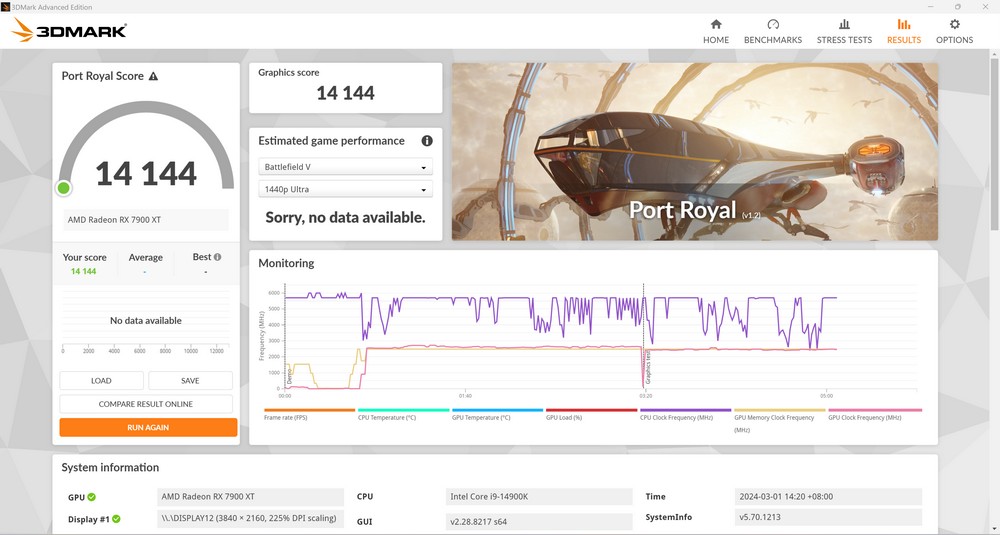
The result of a 3DMark Port Royal benchmark test, which is specifically designed to evaluate real-time ray tracing performance of a graphics card using the DirectX 12 DXR API at 2K resolution. The AMD Radeon RX 7900 XT has scored 14,144 points in this benchmark.
A Port Royal score of 14,144 for the RX 7900 XT indicates strong ray tracing capabilities, which is significant for gamers and professionals looking for realistic lighting, shadows, and reflections in their graphics rendering. Ray tracing is a demanding graphical process that simulates the physical behavior of light, and a high score in this benchmark suggests that the RX 7900 XT can deliver high-quality visuals in ray-traced games and applications.
The monitoring section of the image displays the stability of the system’s frame rate, temperature, and clock frequencies during the test, indicating that the card performs well under the load of ray tracing tasks without significant performance drops or thermal issues.
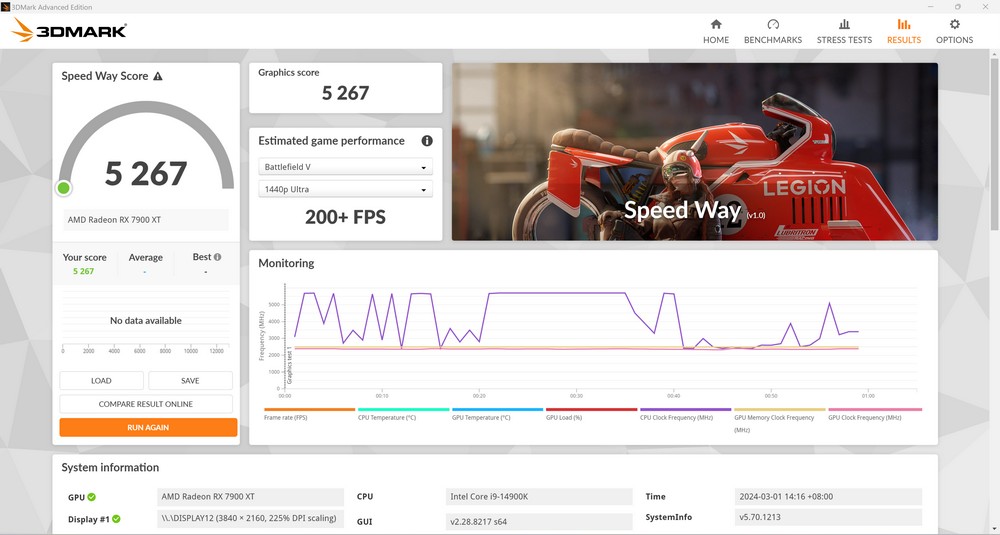
The 3DMark Speed Way benchmark result, which leverages the latest DirectX 12 Ultimate API, including advanced features like DirectX Raytracing (DXR) tier 1.1, global illumination, ray-traced reflections, and Mesh Shaders. These features are part of the cutting-edge technologies that enable highly realistic gaming visuals.
The AMD Radeon RX 7900 XT graphics card scored 5,267 points in the Speed Way benchmark, which is specifically tailored to evaluate real-time ray tracing gaming performance. A score of 5,267 indicates that the RX 7900 XT is quite capable of handling the demands of the latest ray tracing technologies, which are expected to be increasingly common in next-generation games.
The estimated game performance shows over 200 FPS for Battlefield V at 1440p Ultra settings, suggesting that the RX 7900 XT can provide an exceptional gaming experience, offering both high frame rates and high-quality visuals.
The monitoring graph captures the fluctuations in frame rate, as well as the temperature and clock frequencies of the GPU and CPU during the test, helping users understand the stability and efficiency of the hardware under load.
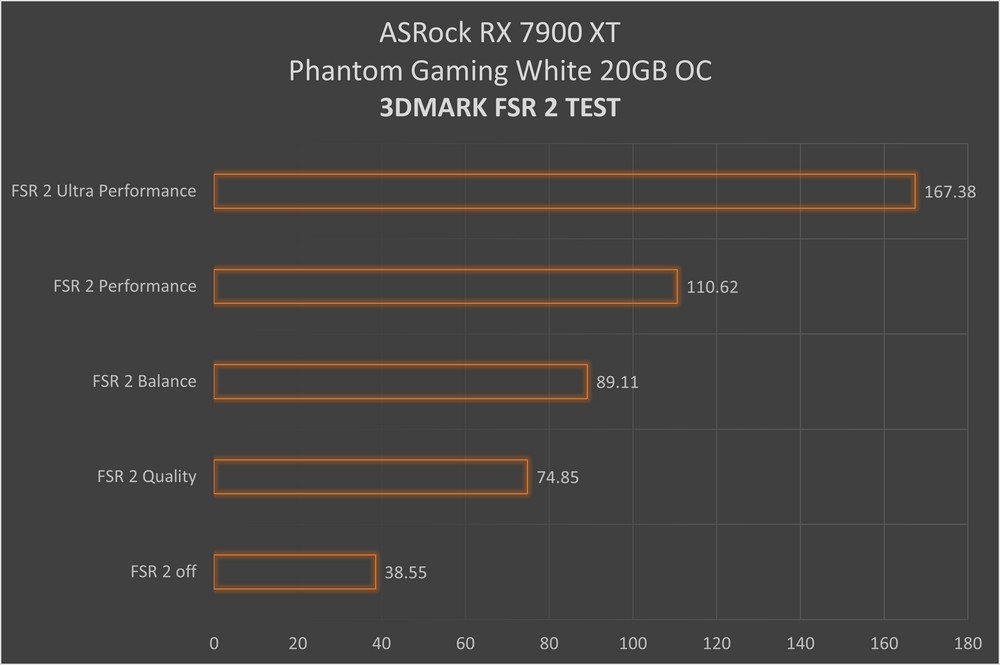
The image shows a comparison test of AMD’s FidelityFX Super Resolution (FSR) 2.0, a performance-enhancing feature that aims to improve frame rates in games by intelligently upscaling lower-resolution images without significantly impacting visual quality. The test results, presumably from 3DMark using the Speed Way scenario, highlight the performance improvements across different FSR 2.0 settings:
- FSR 2 Ultra Performance: 167.38 FPS
- FSR 2 Performance: 110.62 FPS
- FSR 2 Balance: 89.11 FPS
- FSR 2 Quality: 74.85 FPS
- FSR 2 off: 38.55 FPS
The graph illustrates that even at the lowest FSR 2.0 setting (Quality), there’s nearly a 2-fold increase in frames per second compared to having FSR 2.0 turned off, showcasing the technology’s ability to boost performance. The highest setting (Ultra Performance) provides the most significant increase, ideal for users looking for maximum frame rates, possibly at the cost of some image fidelity.
Top-Tier Gaming on ASRock RX 7900 XT Phantom Gaming White: 2K and 4K Performance Across Popular Titles
The benchmark test results for the ASRock RX 7900 XT Phantom Gaming White 20GB OC graphics card, demonstrating its gaming performance at 2K (2560 x 1440) and 4K (3840 x 2160) resolutions. All the settings and special effects were maxed out during the tests, with some games utilizing AMD’s FidelityFX Super Resolution (FSR) to enhance frame rates.
In the tests covering a range of popular and graphically demanding games, the results are as follows:
At 2K resolution, the 7900XT delivers:
- Over 110 FPS in games like “Starfield” and “Call of Duty: Modern Warfare II”
- Over 200 FPS in competitive games like “APEX” and “Rainbow Six Siege”
- AAA titles like “Assassin’s Creed Valhalla” and “God of War” perform well above the 60 FPS mark for smooth gameplay.
At 4K resolution, the performance is more strained, with some games:
- Just managed to hit the basic smooth gameplay mark of 60 FPS
- While others like “Rainbow Six Siege” still achieve an impressive 284 FPS
- High-fidelity games like “God of War” reach around 188 FPS, indicating that the card can handle 4K gaming with some settings adjustments for optimal performance.
These results are crucial for gamers looking to understand the real-world performance of the RX 7900 XT in both competitive and AAA titles at high resolutions. The data also indicates that activating FSR can nearly double the frame rates in certain titles, showing the technology’s impact on enhancing gaming experiences.
Exploring Ray Tracing Capabilities: ASRock RX 7900 XT Phantom Gaming White’s Performance in Leading Titles
A performance comparison of the ASRock RX 7900 XT Phantom Gaming White 20GB OC graphics card in various modern titles at 2K (2560 x 1440) and 4K (3840 x 2160) resolutions, emphasizing the impact of FSR (FidelityFX Super Resolution) and ray tracing technologies on frame rates.
The key takeaways from these benchmarks are:
At 2K resolution:
- Games like “Hogwarts Legacy” and “Forza Horizon 5” show excellent performance with FSR on, hitting 168 and 179 FPS respectively.
- Even more demanding titles such as “Cyberpunk 2077” and “Watch Dogs: Legion” perform decently, delivering above 60 FPS with FSR enabled.
At 4K resolution:
- Performance takes a hit across all titles, struggling to maintain 60 FPS, with ray tracing and FSR demanding more from the GPU.
- However, “Far Cry 6” and “F1 23” still manage playable frame rates with FSR, at 89 and 39 FPS respectively.
Ray Tracing Impact:
- The performance impact of ray tracing is highlighted, especially in “Watch Dogs: Legion,” with frame rates dropping significantly when ray tracing is enabled.
FSR Effectiveness:
- The results illustrate the effectiveness of FSR in improving frame rates, nearly doubling the performance in some cases and close to tripling in 4K resolution with ray tracing enabled.
ASRock RX 7900 XT Phantom Gaming White: Power Efficiency and Thermal Performance Under Extreme Load
The power consumption and thermal performance of the ASRock RX 7900 XT Phantom Gaming White 20GB OC graphics card under various stress conditions. The tests were conducted in an open platform with a room temperature of 23 degrees Celsius, using tools such as FurMark 2 for extreme load simulation, Cyberpunk 2077 to represent real-world gaming, and 3DMark Fire Strike Ultra to simulate gaming loads. The HWiNFO64 software was utilized to record power and temperature metrics.
The key outcomes of the tests are as follows:
- During the FurMark 2 stress test, the card exhibited an average power consumption of 318 watts, reaching a cool temperature of just 62.5 degrees Celsius, which implies efficient thermal management and low noise from the cooling fans.
- In idle mode, with the fans stopped, the card maintained a temperature of 35 degrees Celsius, indicating minimal thermal stress and effective passive cooling.
Summarize
The ASRock RX 7900 XT Phantom Gaming White graphics card makes a striking impression with its bold white and purple colour scheme and design that radiates style. A metal backplate and reinforced mid-frame ensure the card retains its shape, while tasteful RGB elements add a touch of sophistication. Its zero RPM feature under low temperatures ensures efficiency and noise reduction. Even under heavy load, the cooling system performs exceptionally well, keeping temperatures just over 60 degrees Celsius.
Equipped with a TSMC 5nm process core, 80MB of Infinity Cache, and 20GB of GDDR6 memory, the card meets most gaming requirements with high frame rates at 2K resolution and satisfactory performance at 4K resolution without ray tracing. Its ray tracing capabilities have significantly improved over the previous generation, making it more than capable at 2K resolution. With a generous 20GB of VRAM, it is well-positioned to handle future games that are increasingly demanding on video memory, providing a competitive advantage.
If this article is helpful for you, please share this article with your friends on social media. Thank you!
This article is based on the personality of the reviews. You are responsible for fact-checking if the contents are not facts or accurate.
Title: ASRock Phantom Gaming White Edition: Elevating AMD Radeon RX 7900 XT to New Heights in Gaming Performance and Style